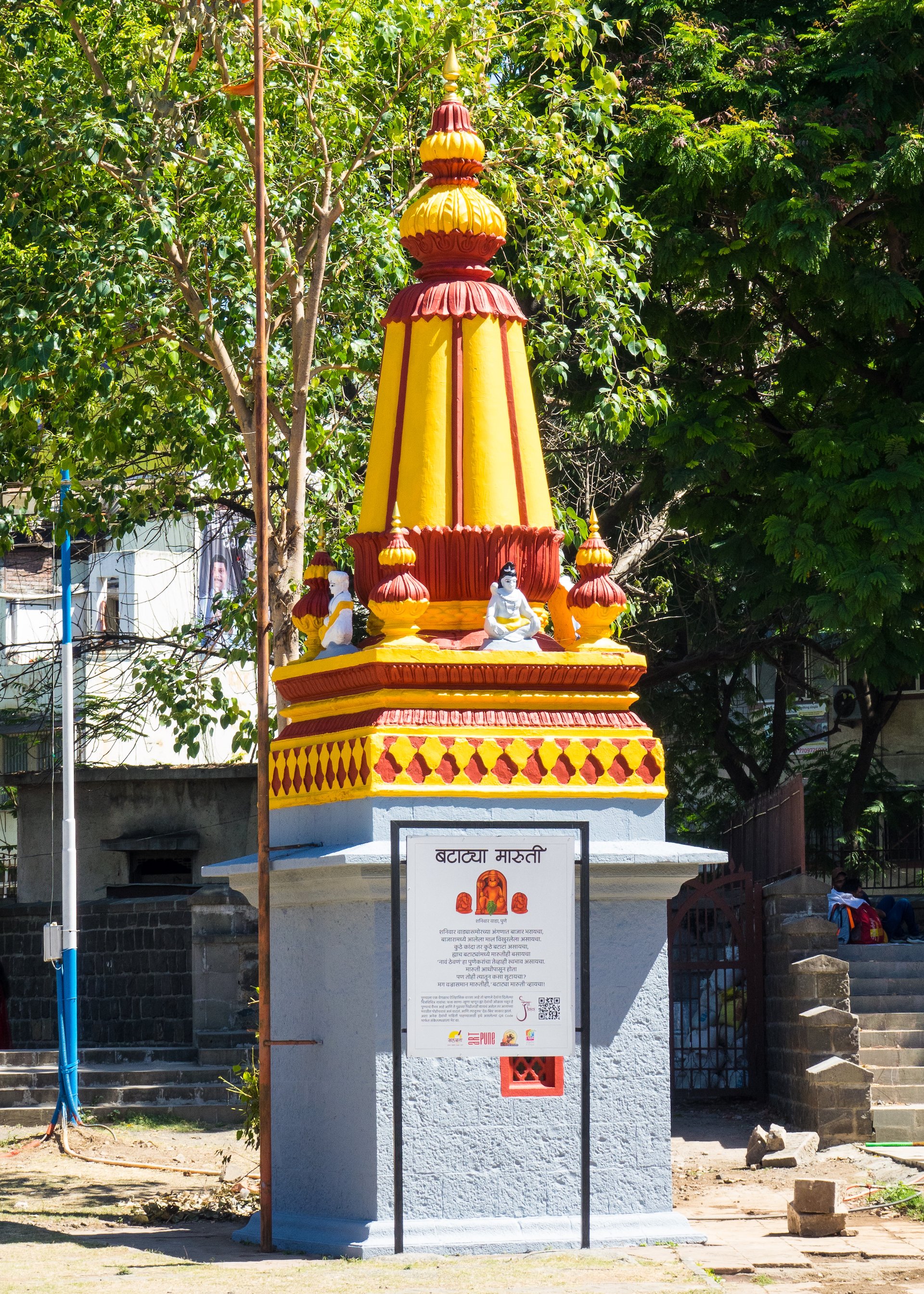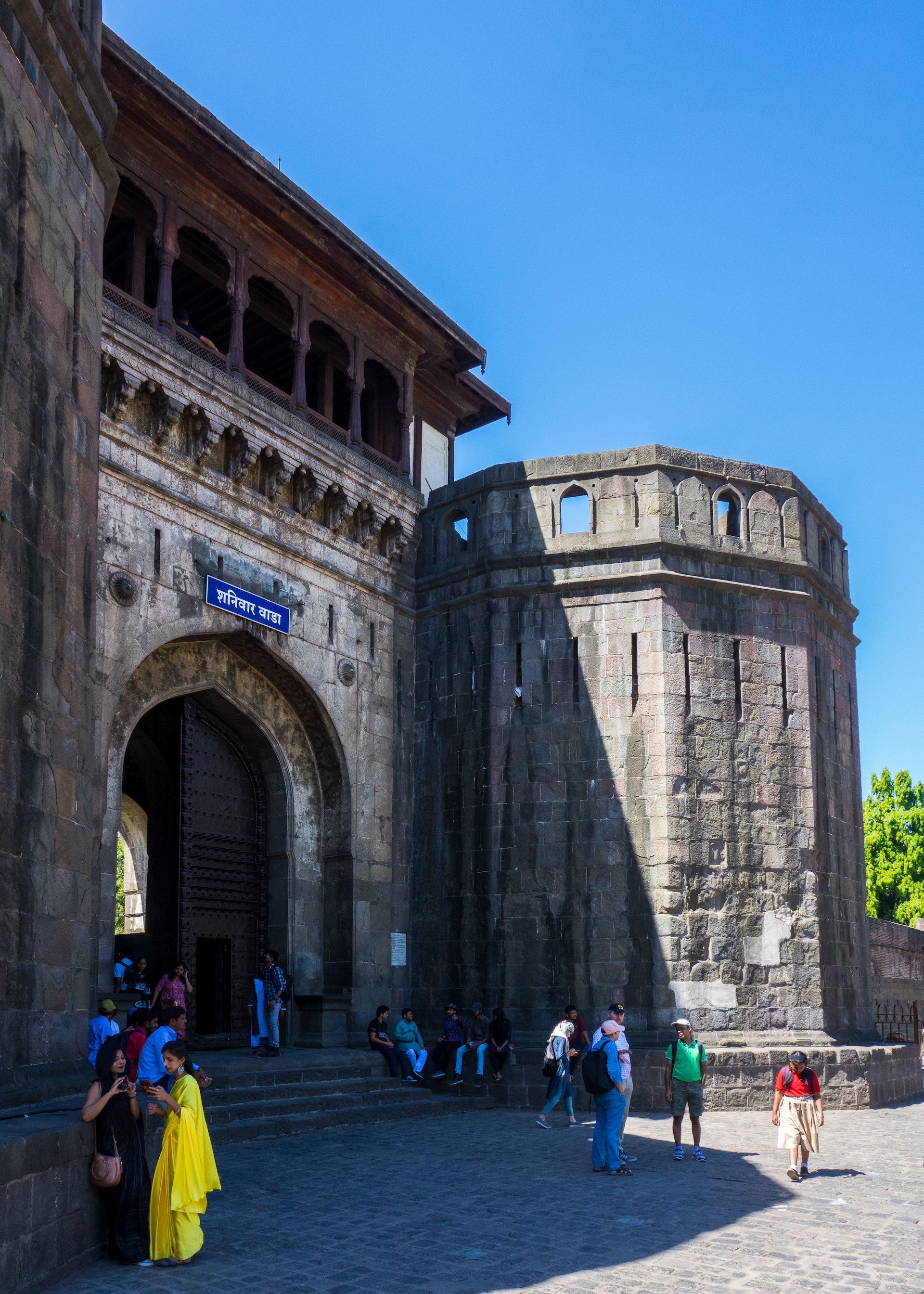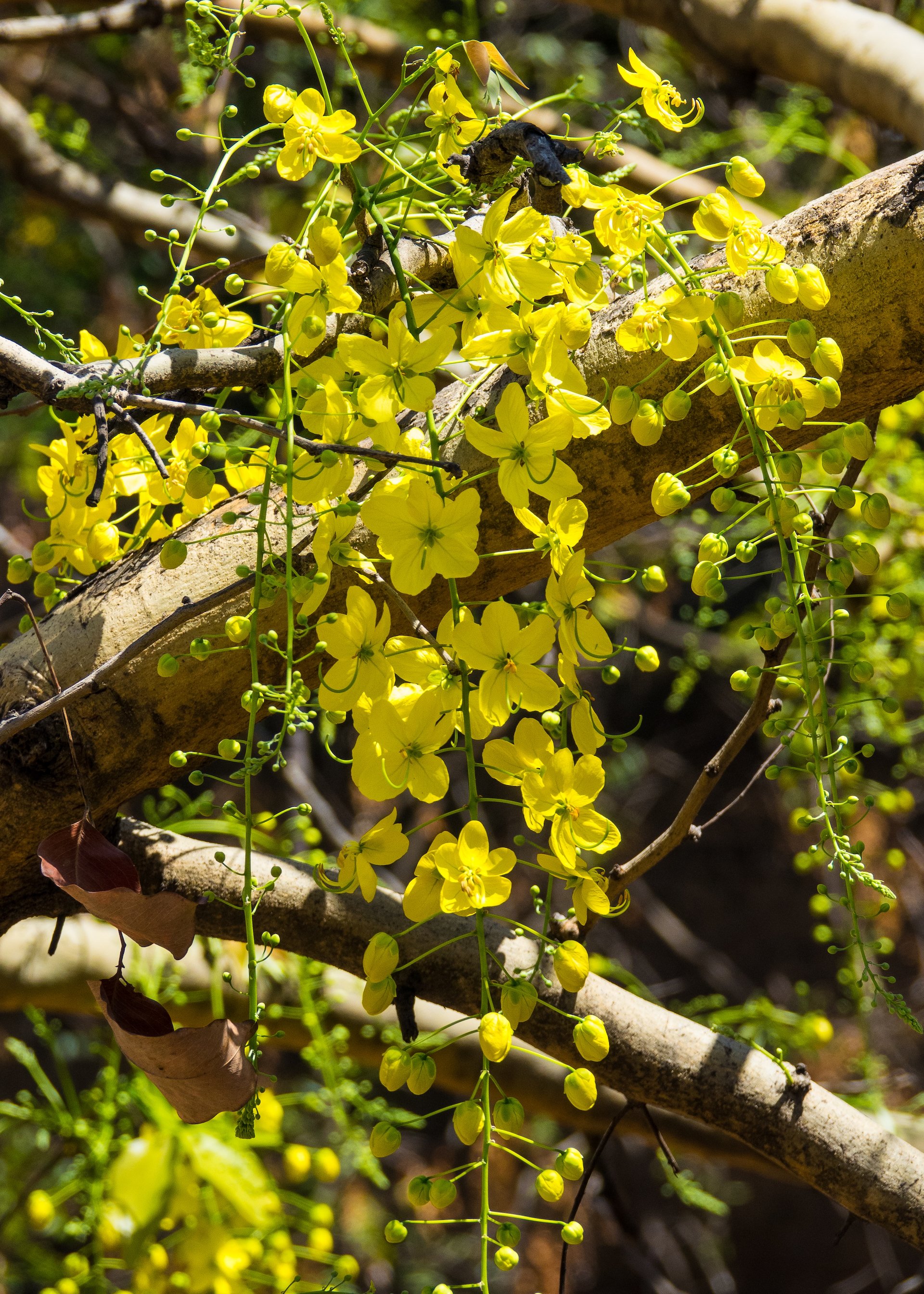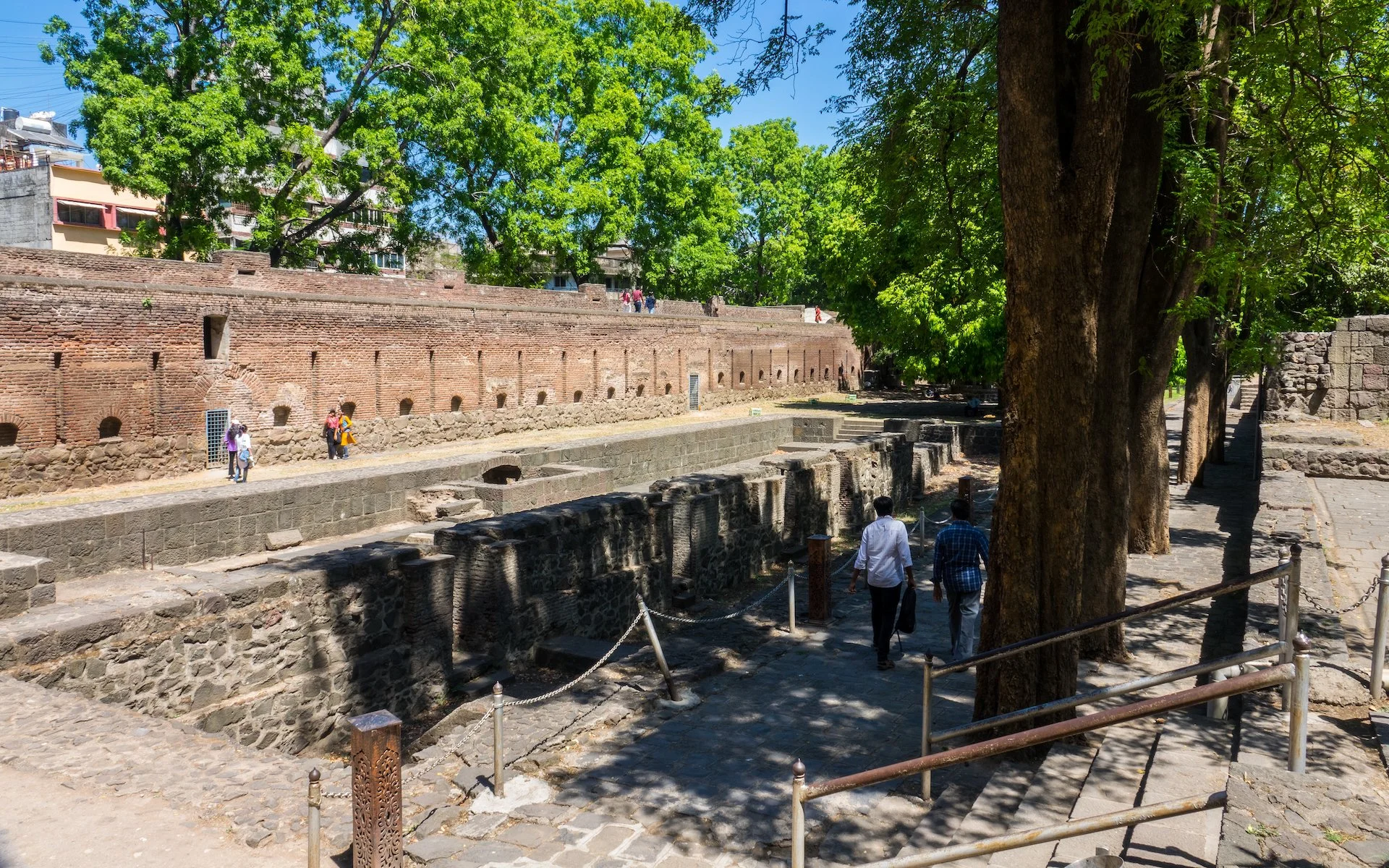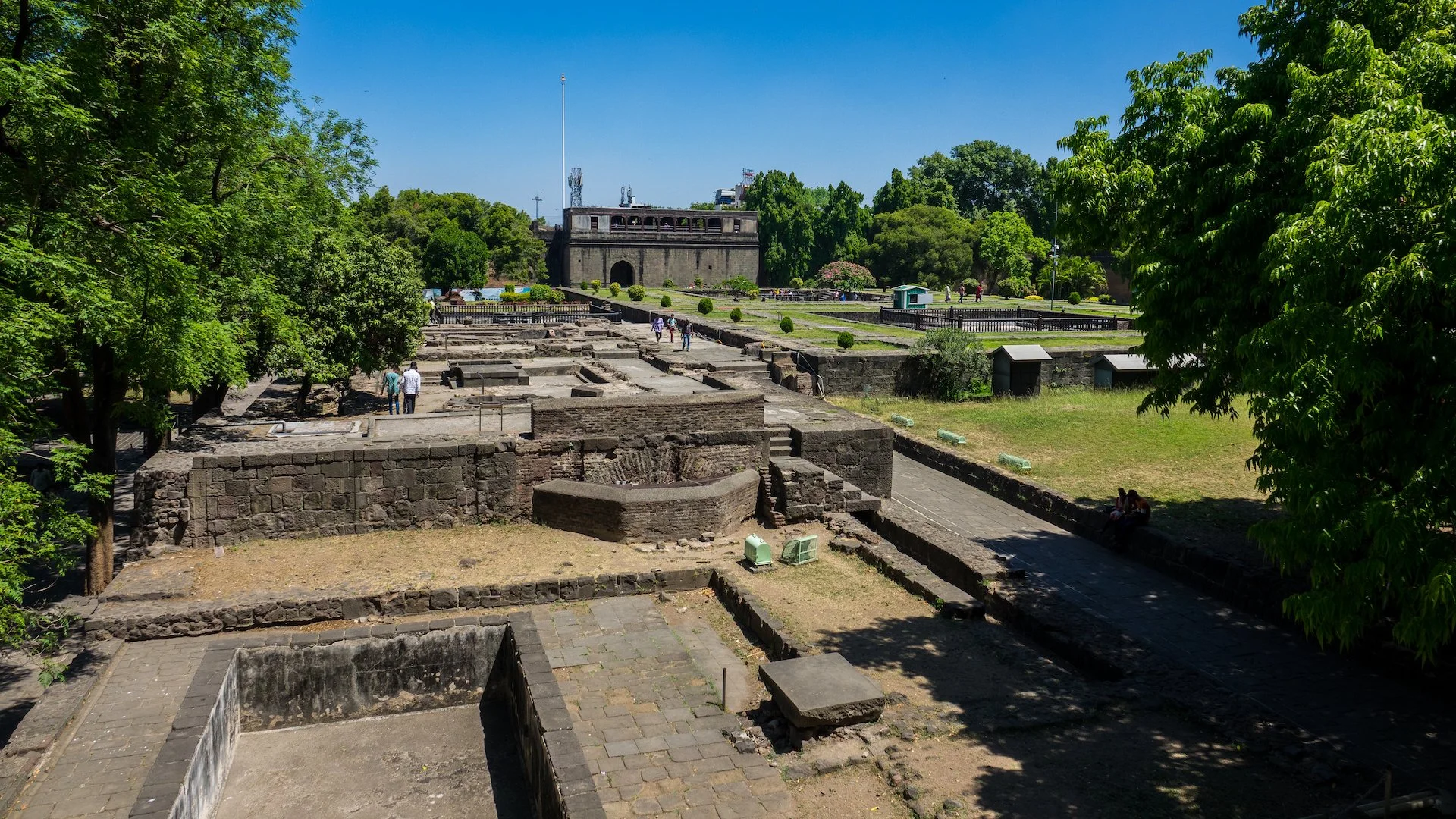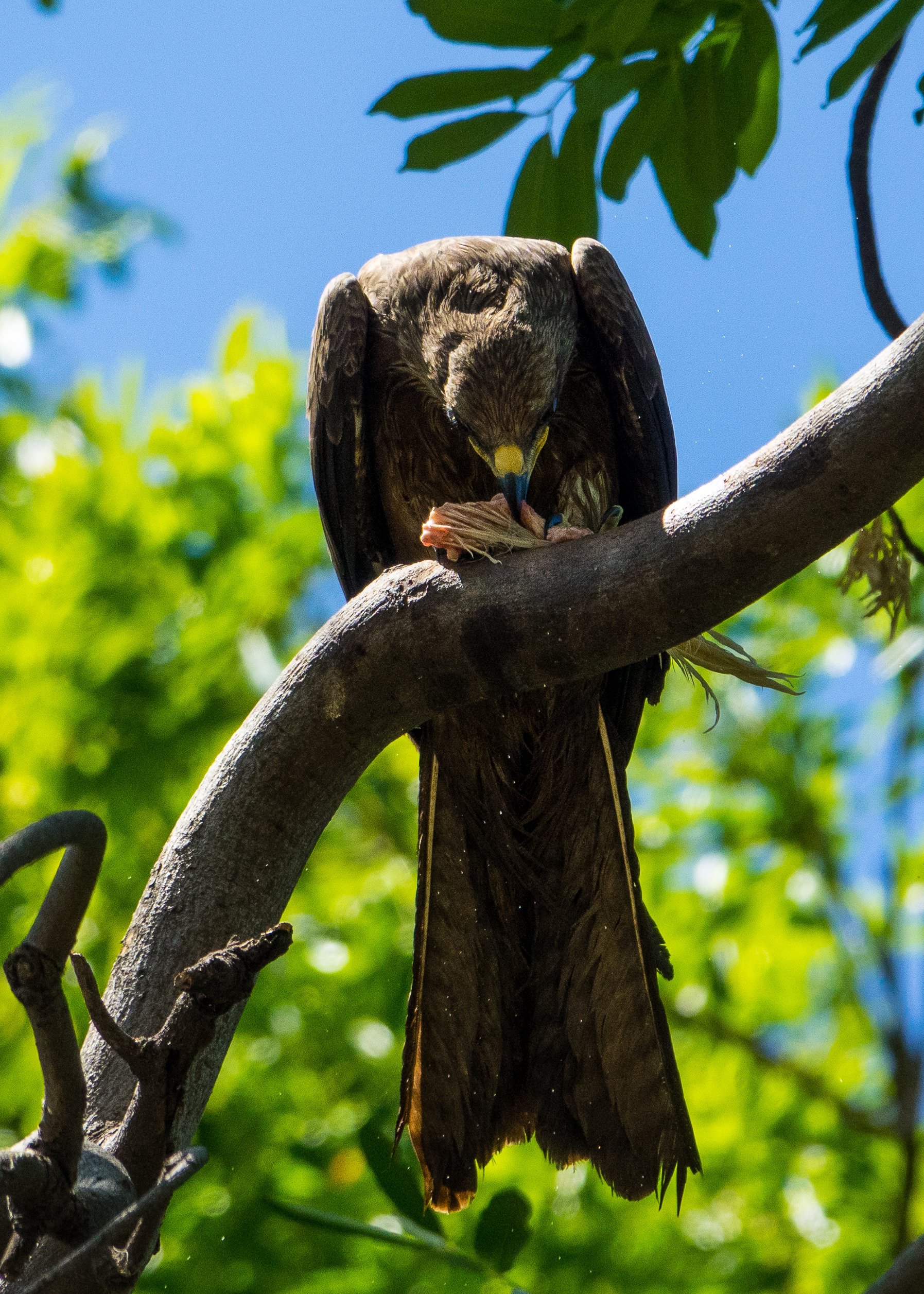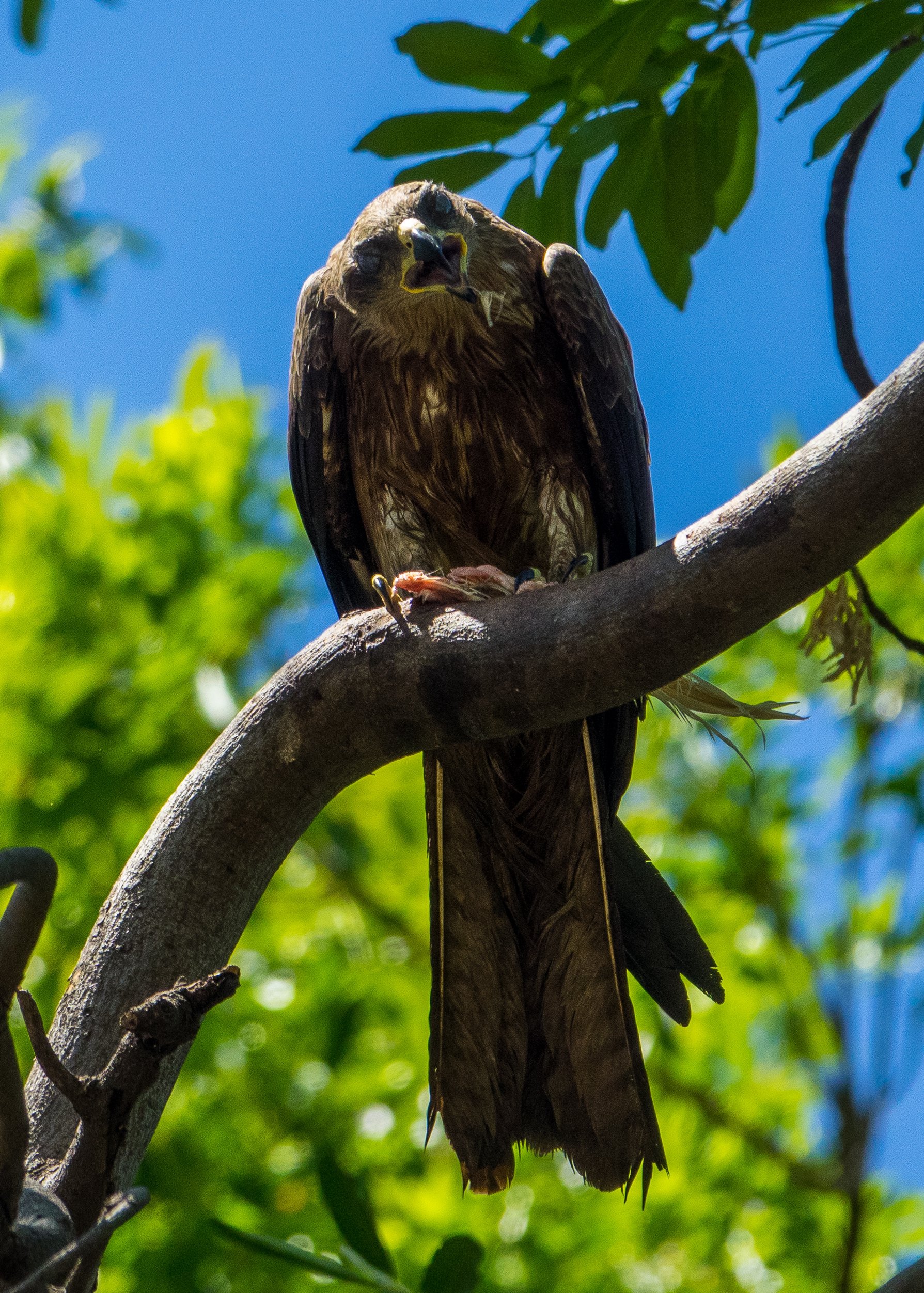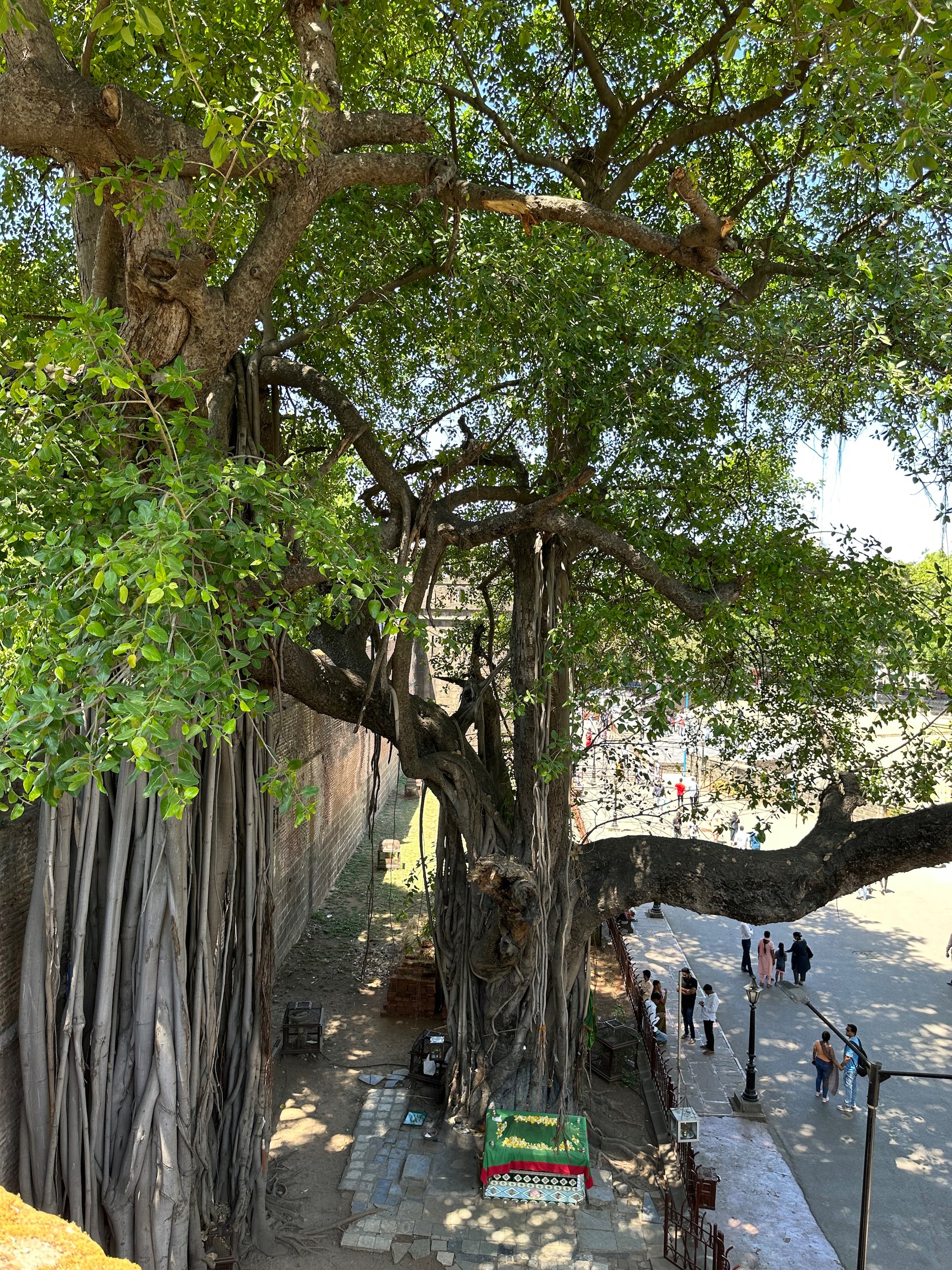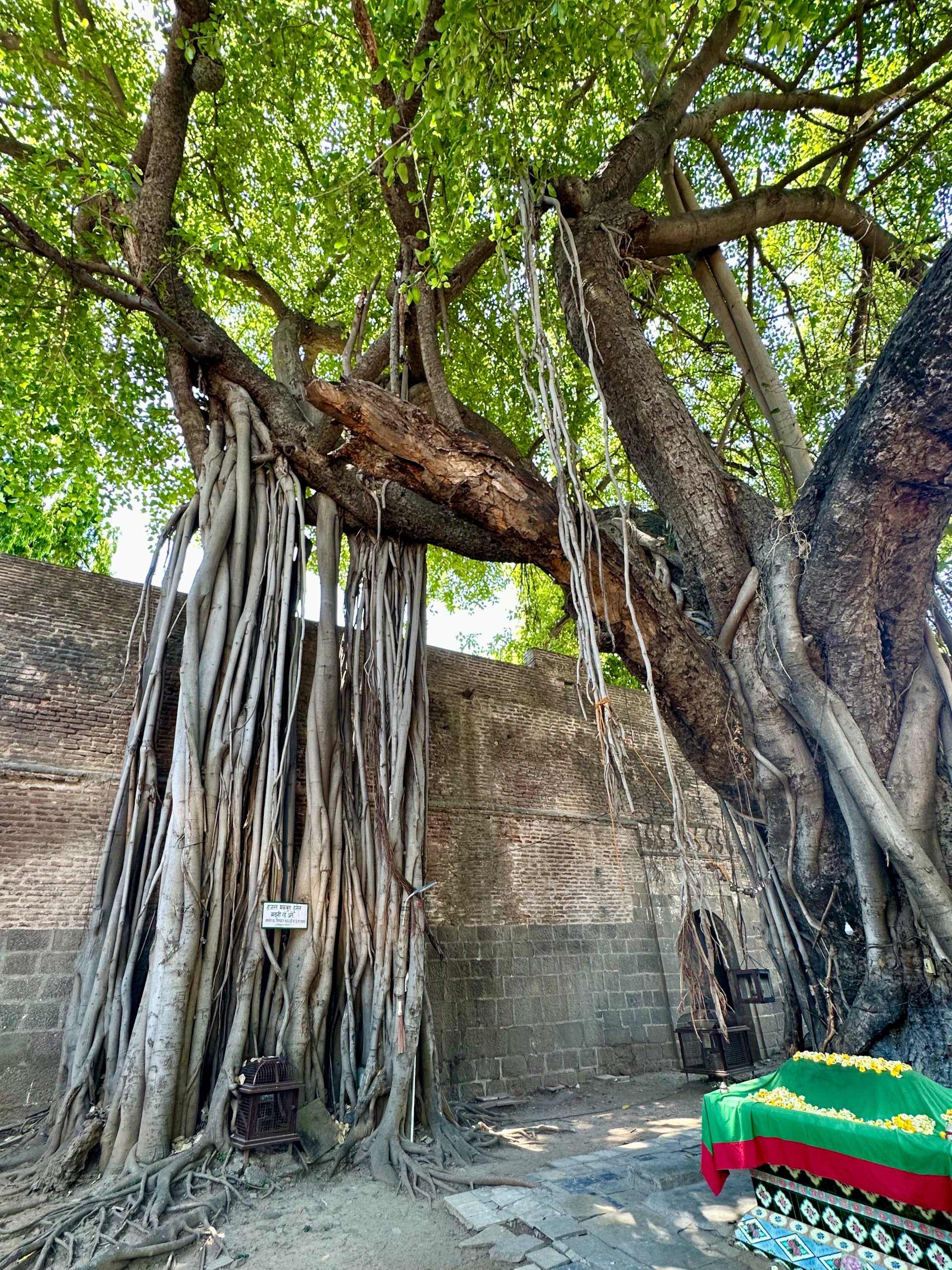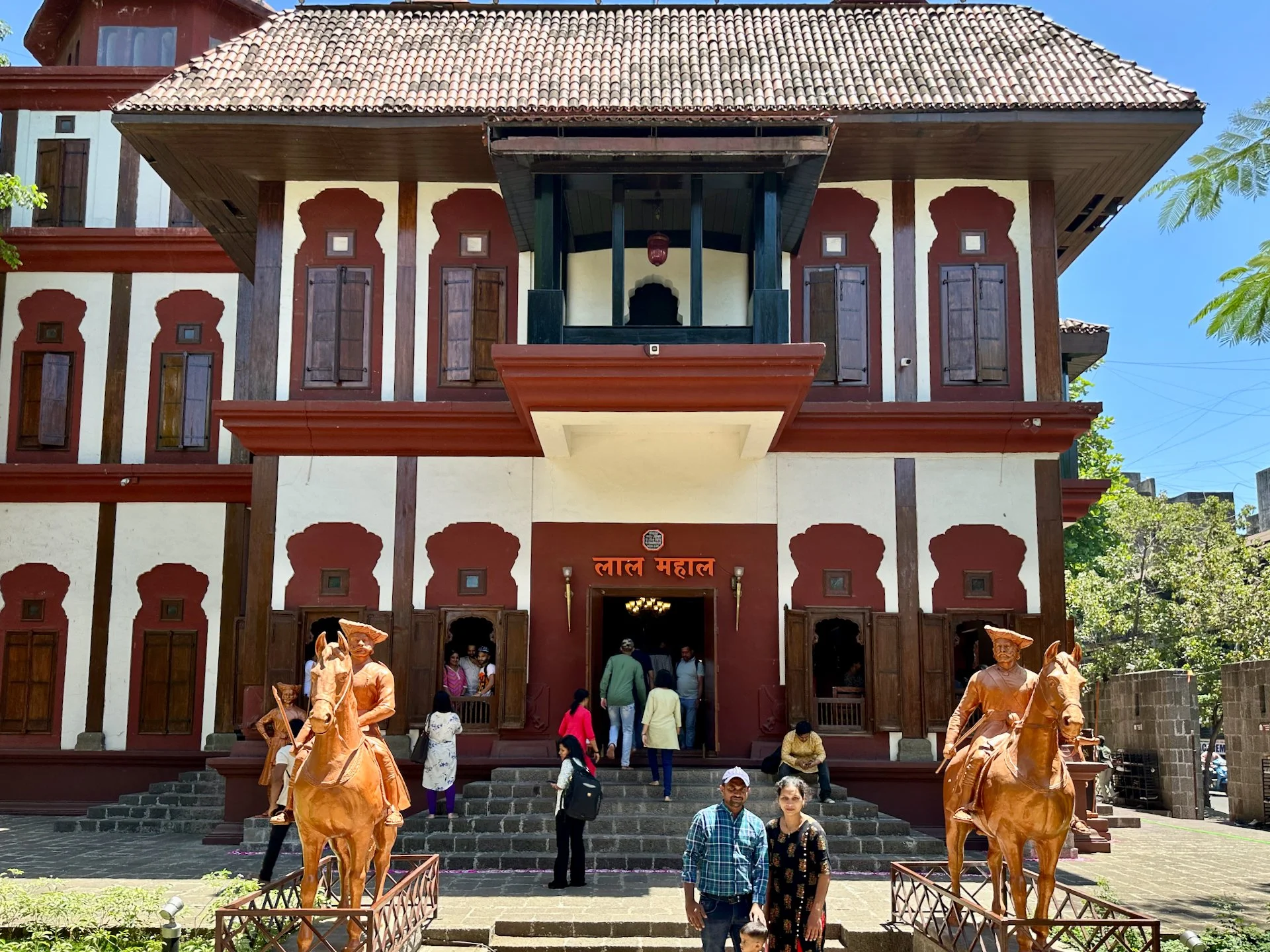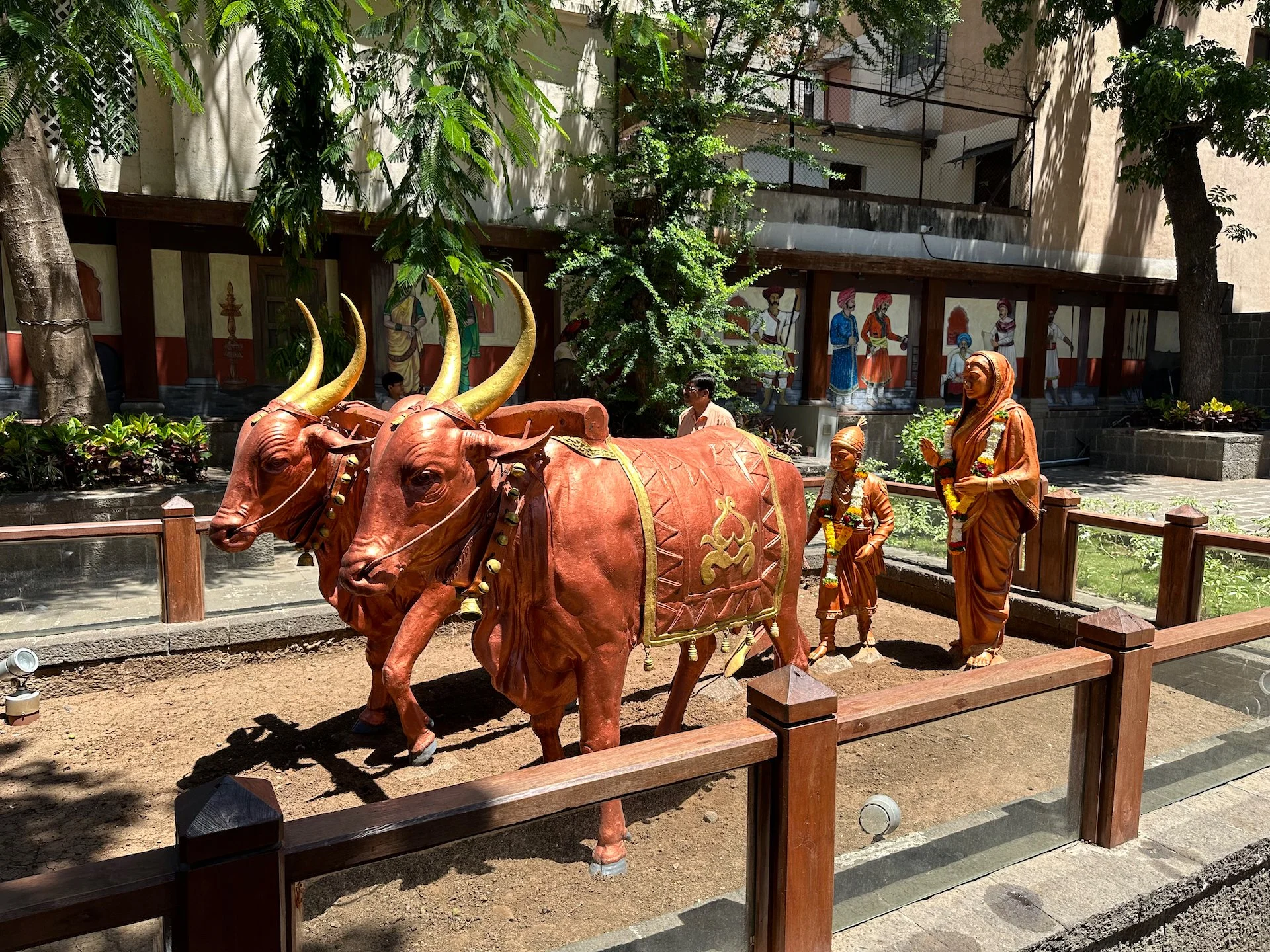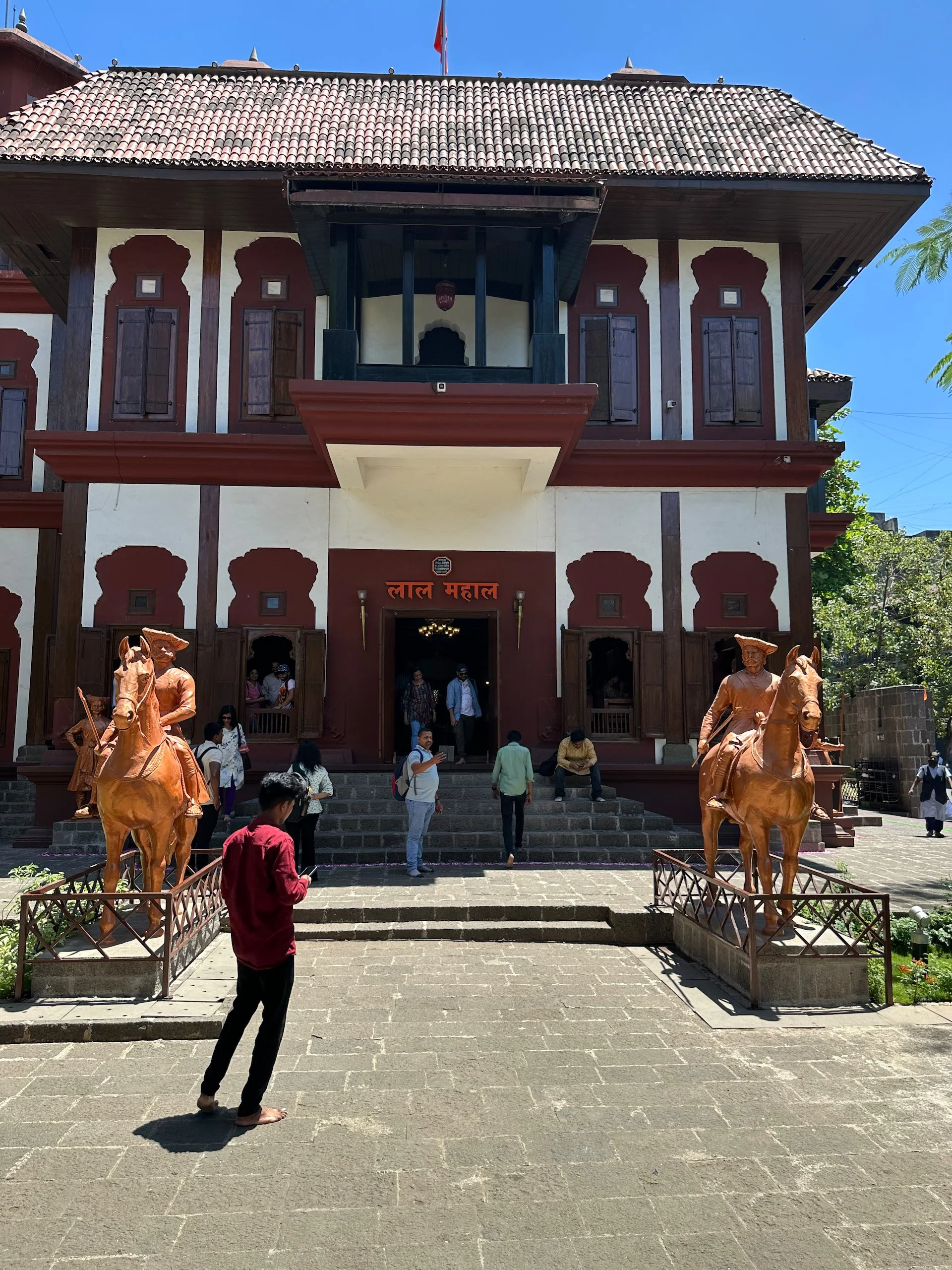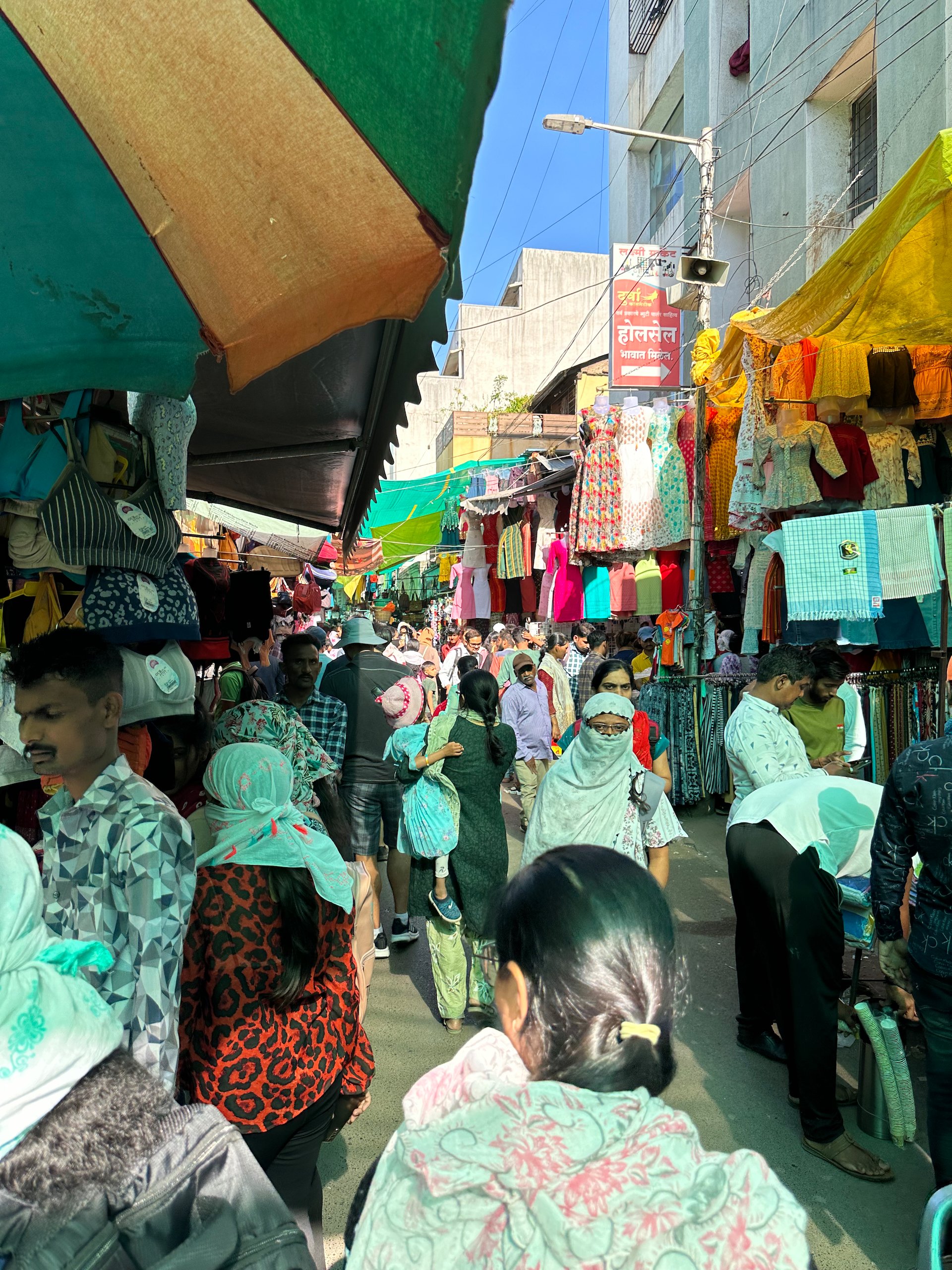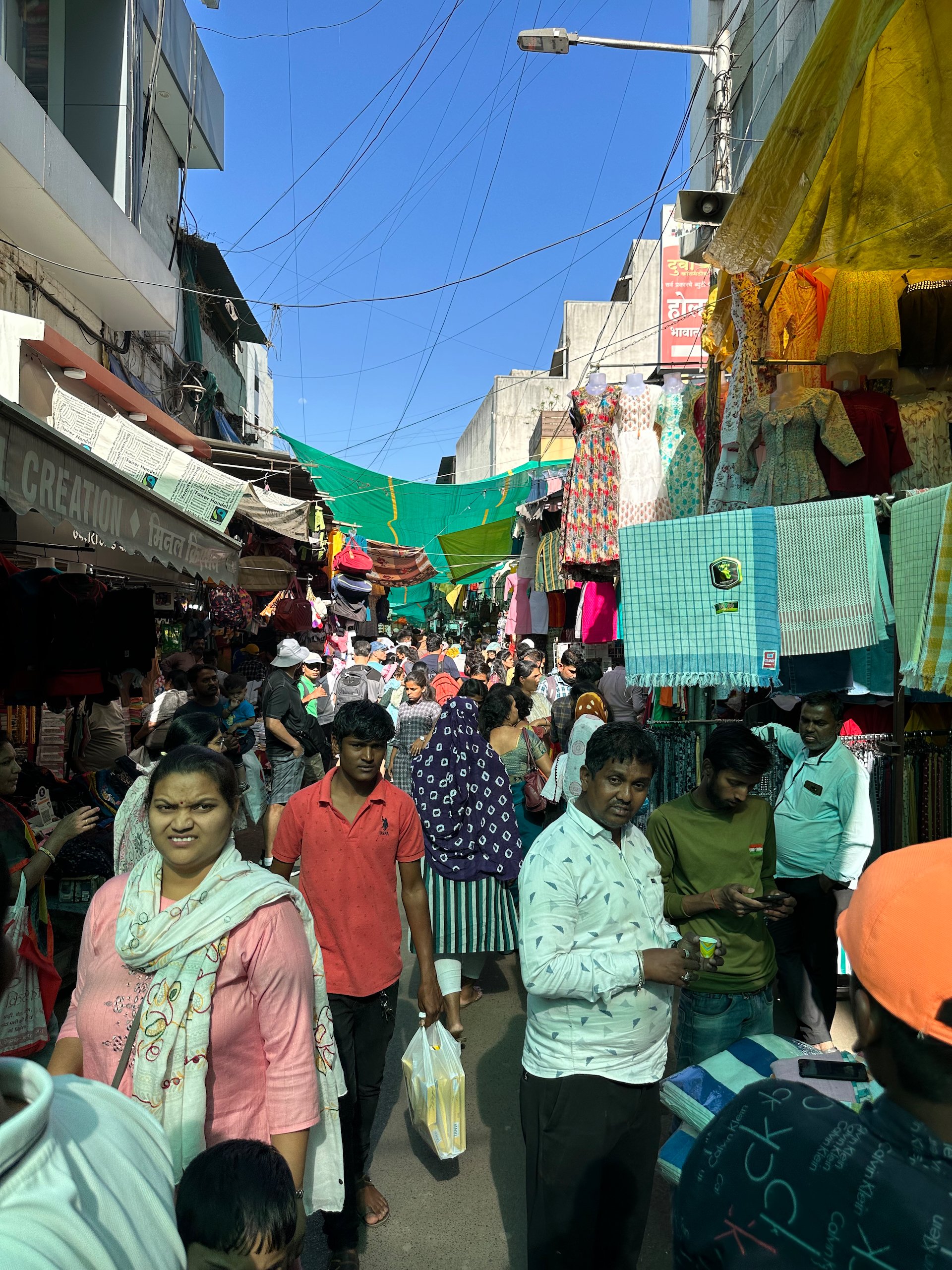We were taken on a city tour by a couple of the local team members, Mukesh and Salil. We met in the lobby of the hotel around 10:00 and headed out for the day. There were 7 of us plus our two local “guides” who did a great job helping us to understand all the details of the local history and culture as we explored the city. We barely scratched the surface, but they were awesome guides for us.
Shaniwar Wada
The front entrance to the palace.
Our first stop was the Shaniwar Wada, or the “Saturday Palace”. Apparently, it got this name as there was historically a big market outside it on Saturdays. We were dropped off by our drivers and we had a chance to explore the palace for a couple of hours.
Shaniwar Wada is a historical fortification that was built in 1732 and was the seat of the Peshwa rulers of the Maratha Empire. The palace is a unique historical monument that represents the rich cultural heritage of Pune and the Maratha Empire. The fortification is a blend of Indian and Western architectural styles.
The construction of Shaniwar Wada was commissioned by Baji Rao I, the second Peshwa of the Maratha Empire. The fortification was built to serve as the seat of the Peshwa rulers and as a center of administration for the Maratha Empire. The construction was completed in 1732 and it became the residence of the Peshwa rulers – particularly the “Prime Minister”, who is appointed by the king.
A full view of the front entrance.
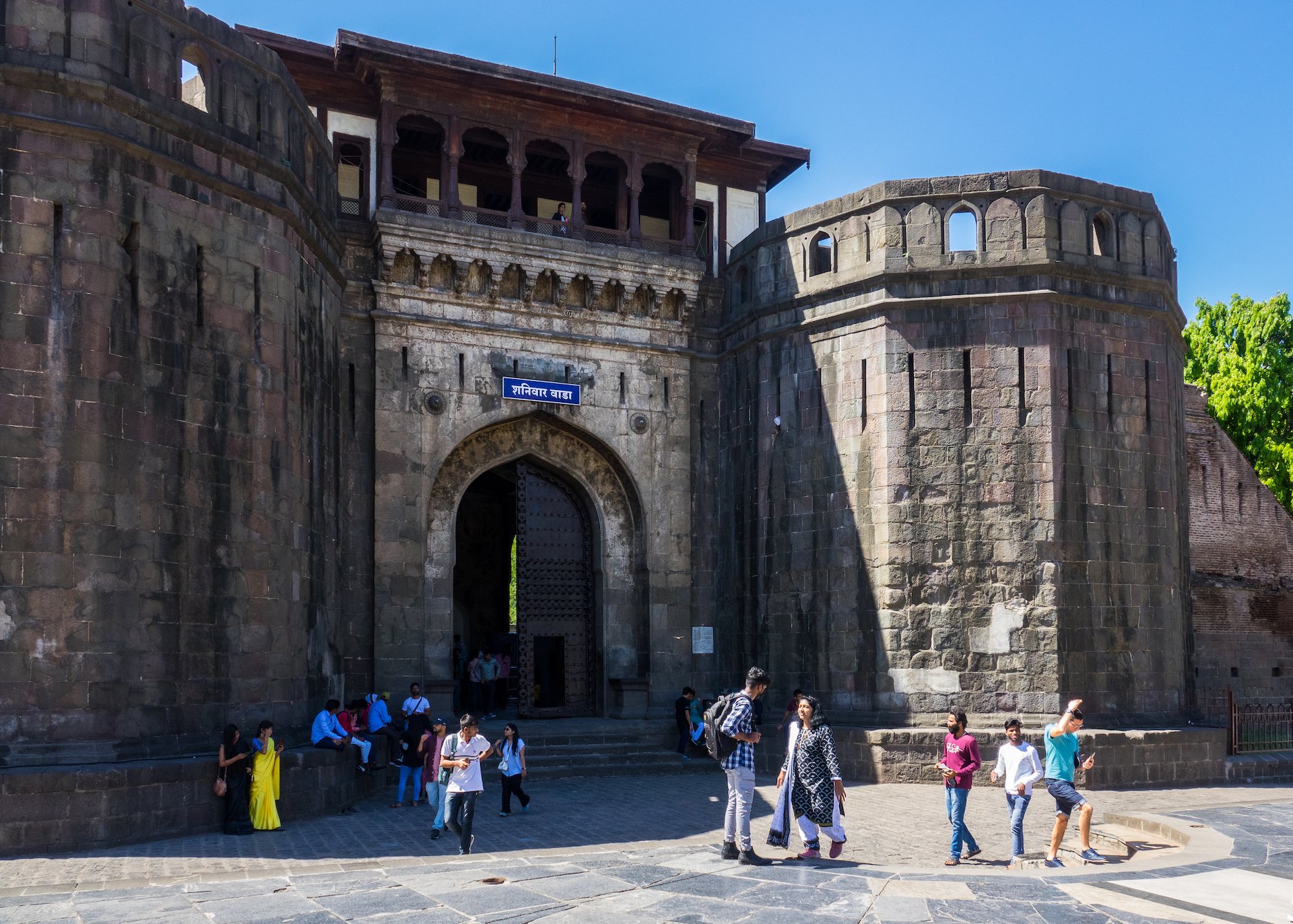
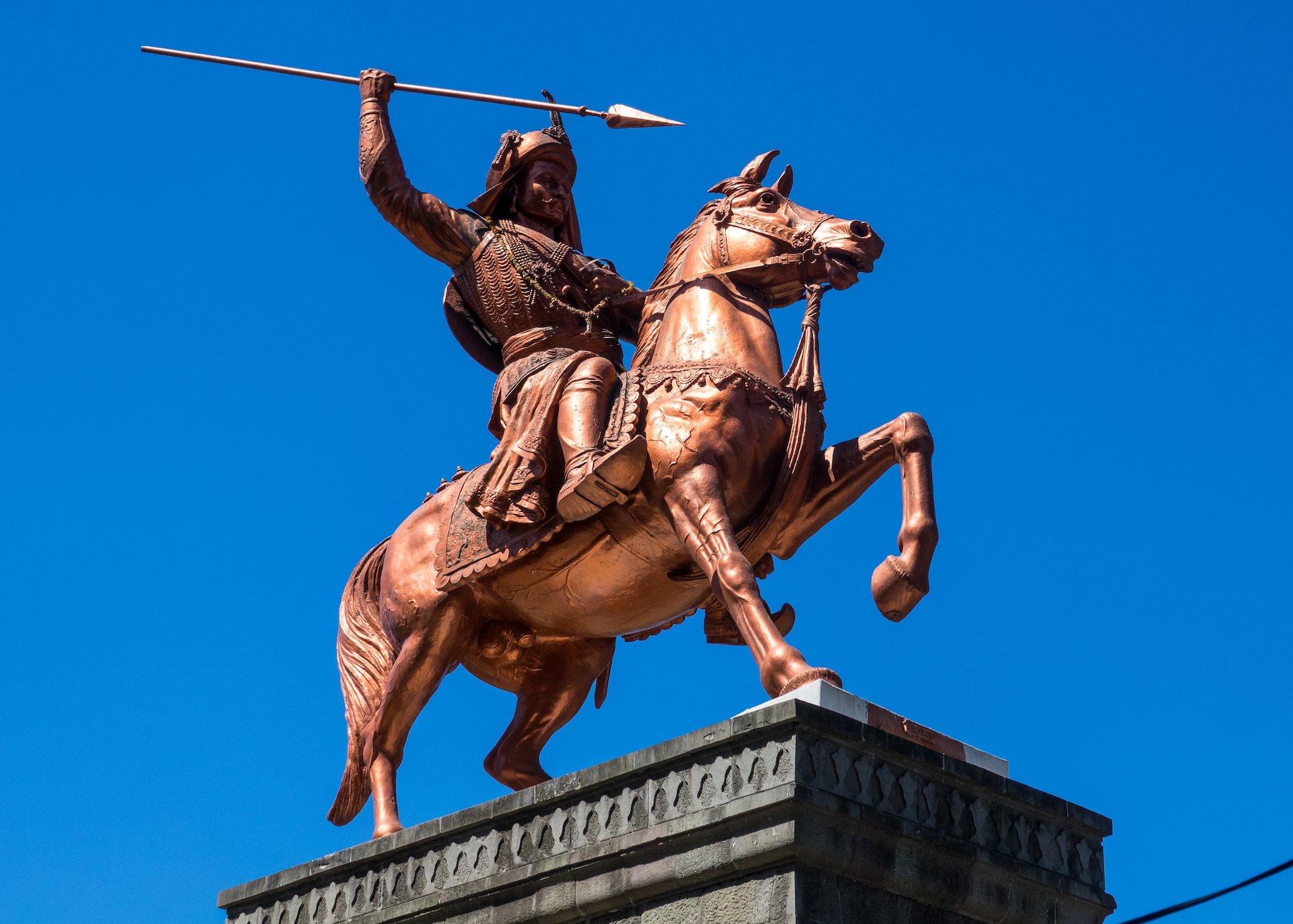
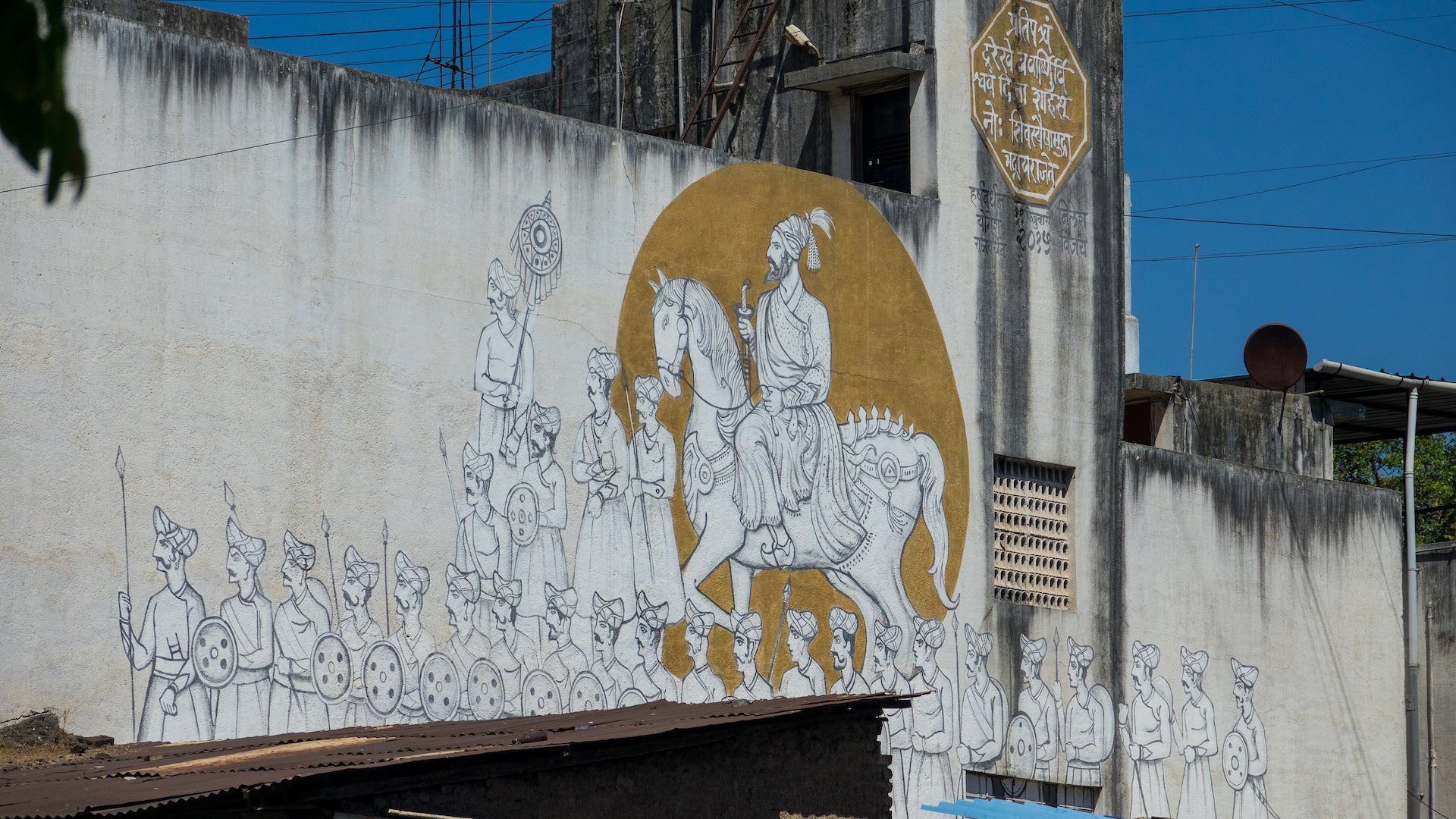
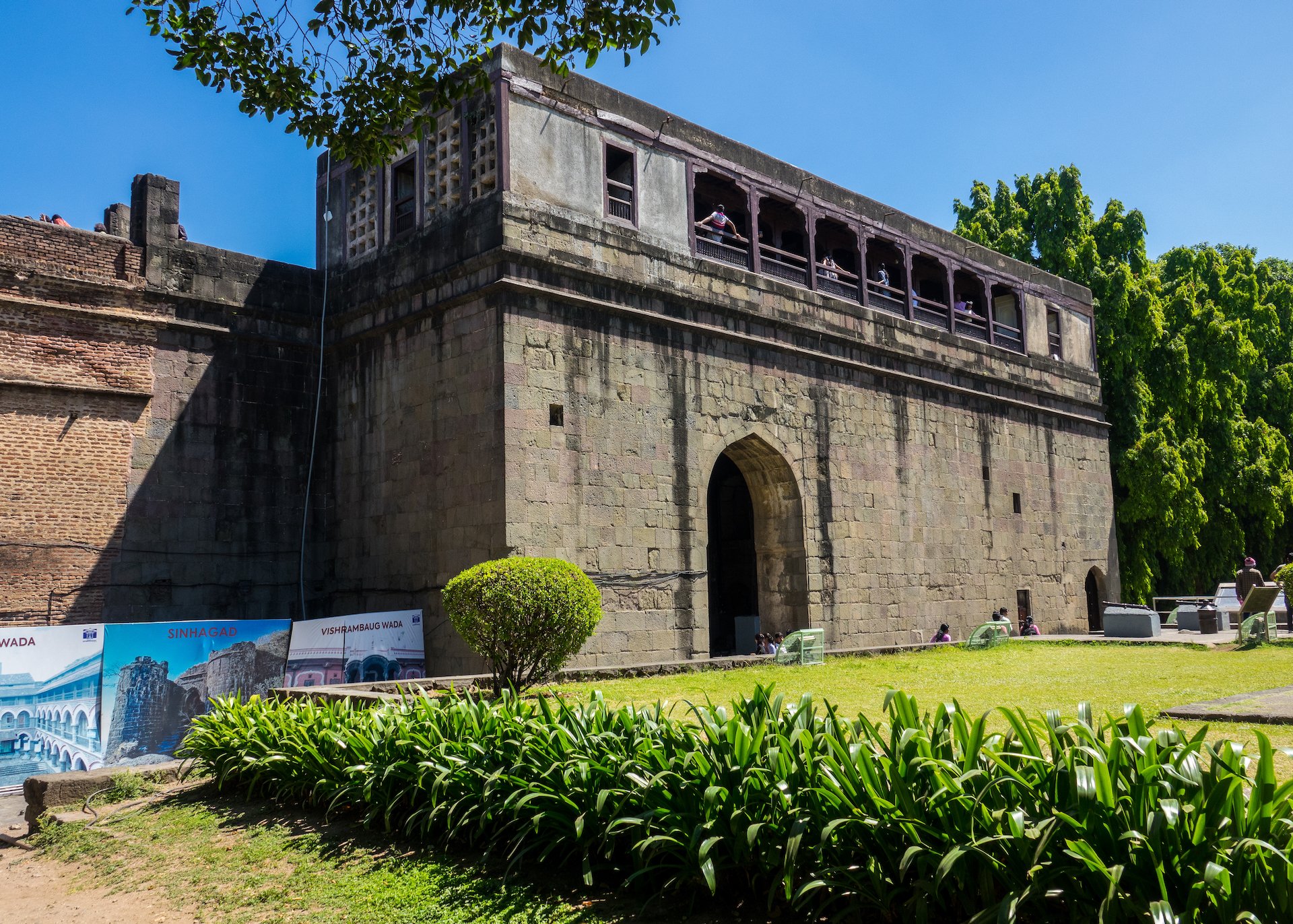
Shaniwar Wada is a unique architectural marvel that represents the rich cultural heritage of the Maratha Empire. The fortification is a blend of Indian and Western architectural styles, which is evident in its massive stone walls, intricate carvings, and ornamental gateways. The main entrance of the fortification is called the Dilli Darwaza, which is adorned with exquisite carvings and intricate designs. The massive spikes on the main gate are there to repel elephants used as battering rams in local warfare. Not something that you see every day…
This is how you stop elephants from battering down your gates.
The fortification has five gates and nine bastions, including the Mastani Darwaza, the Khidki Darwaza, and the Ganesh Darwaza, each with its own unique design and significance. Most of these were not available to explore as they are closed off to keep people going through the main entrance.
This fountain was an element of the palace, a fountain in the shape of a lotus flower that was a wonder for its time.

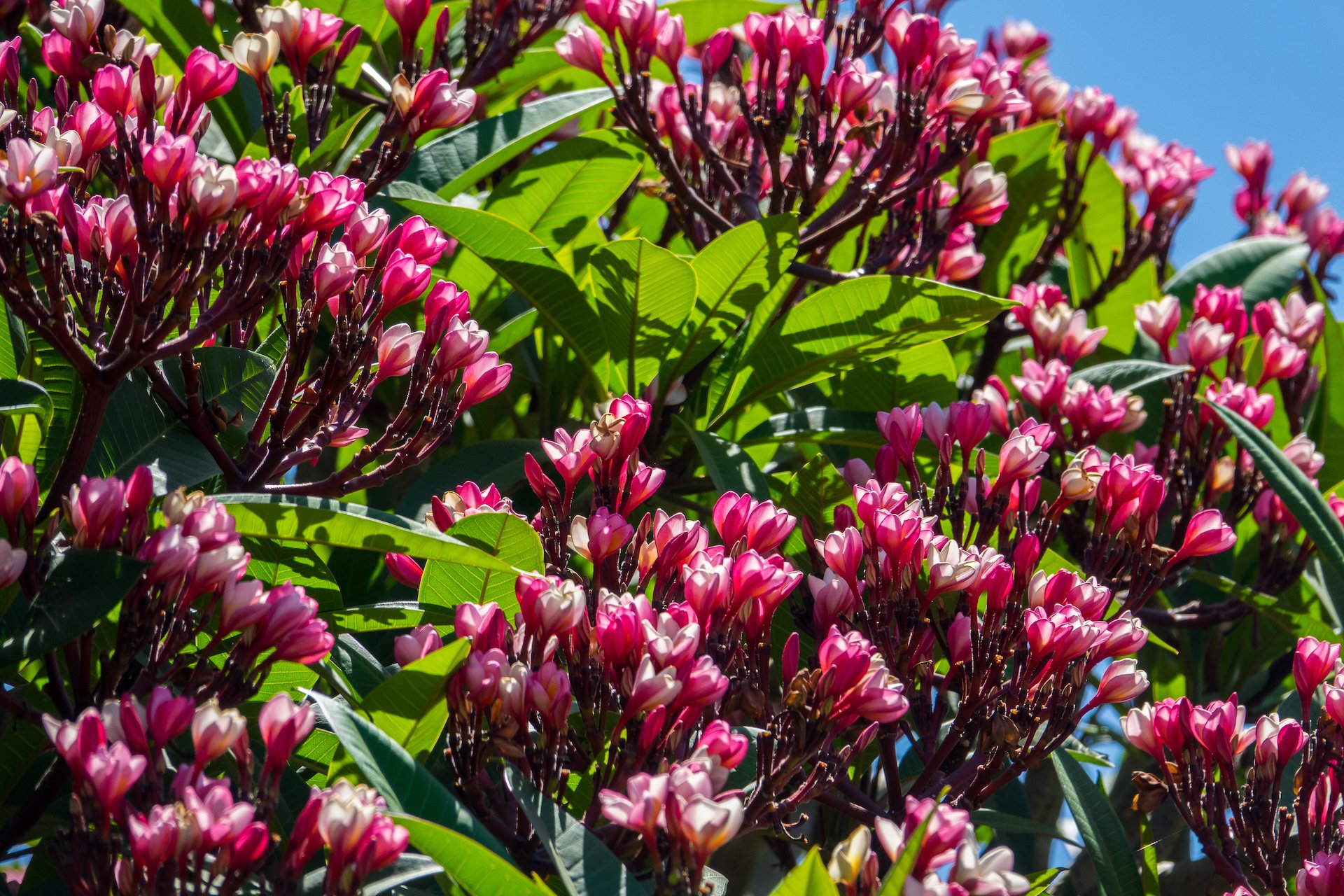
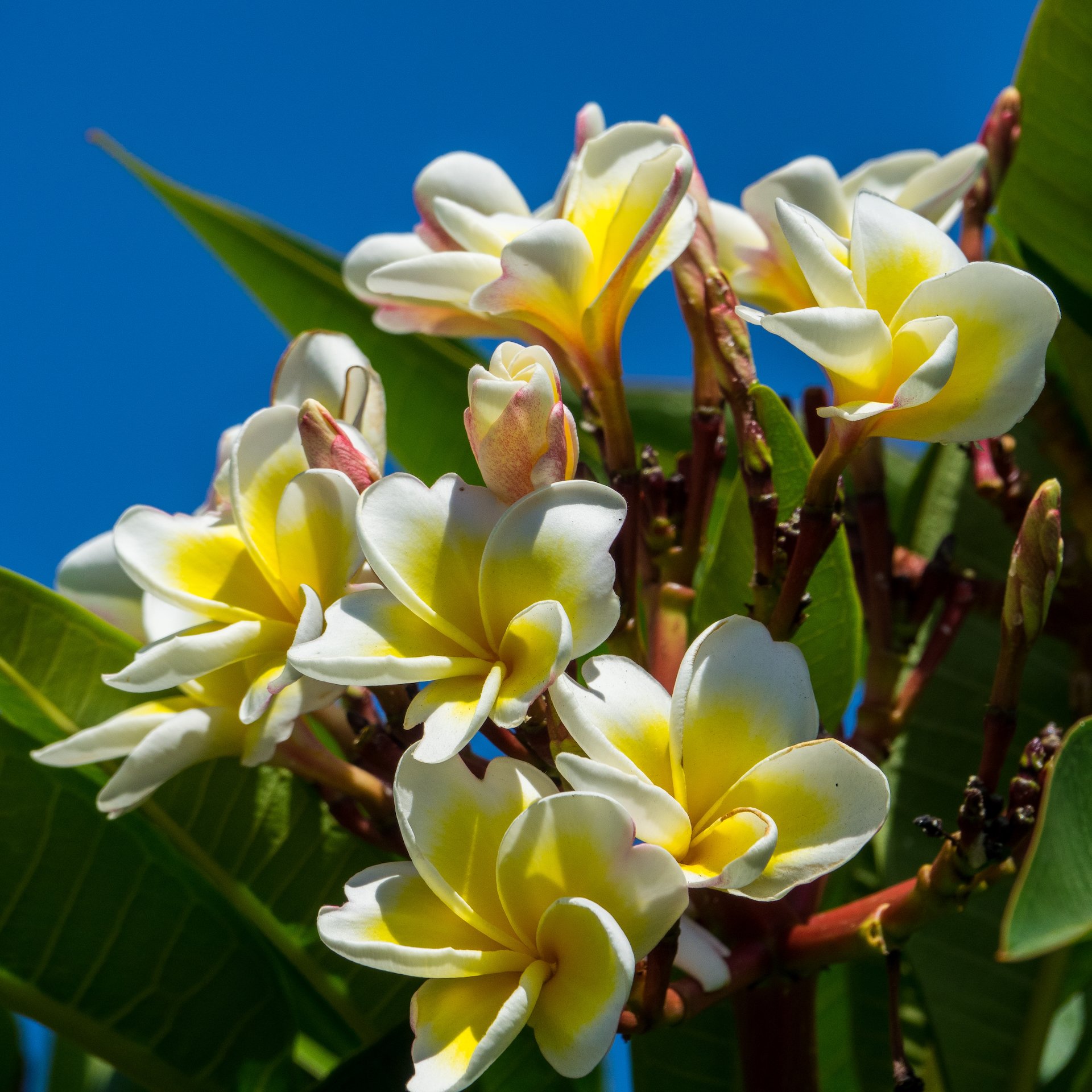
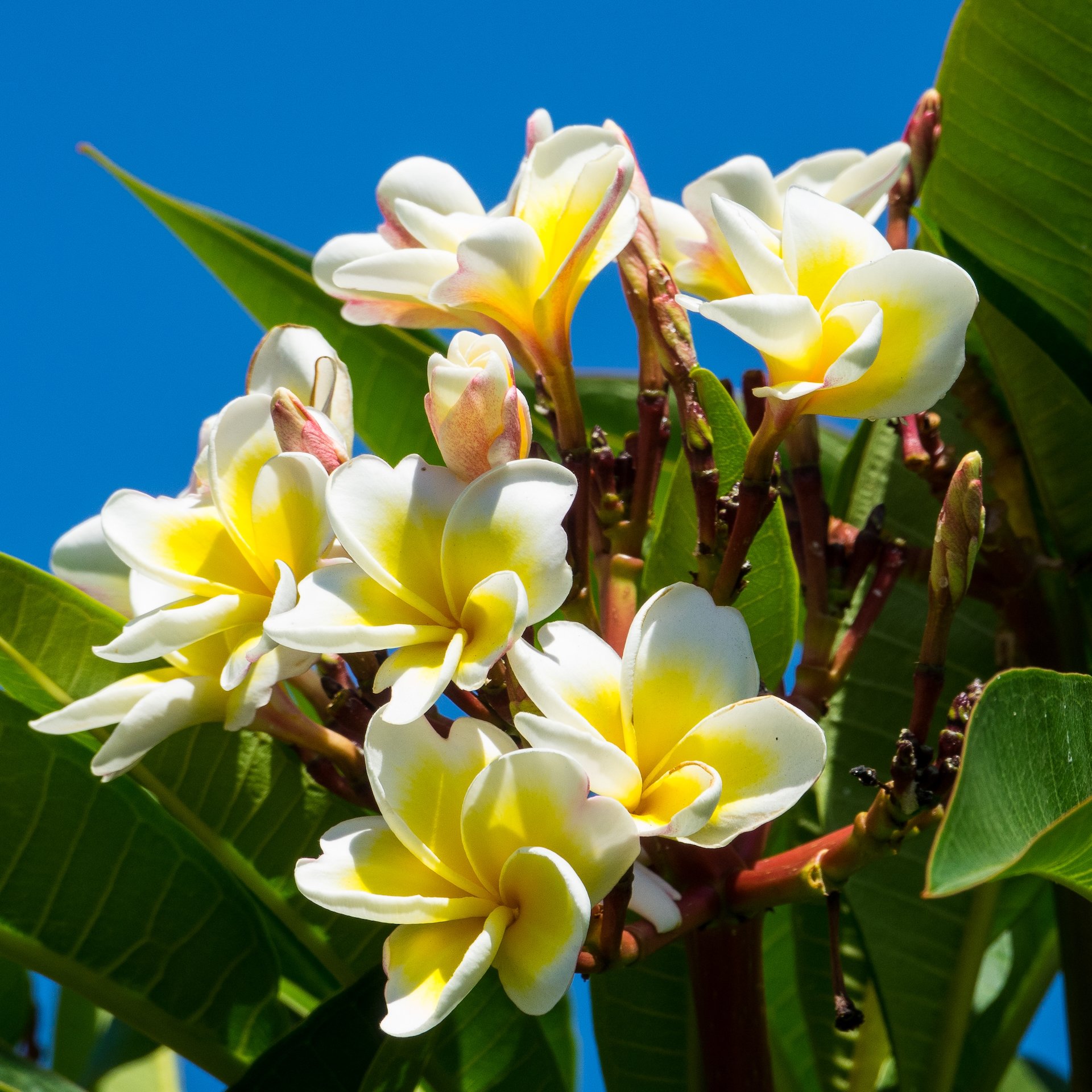
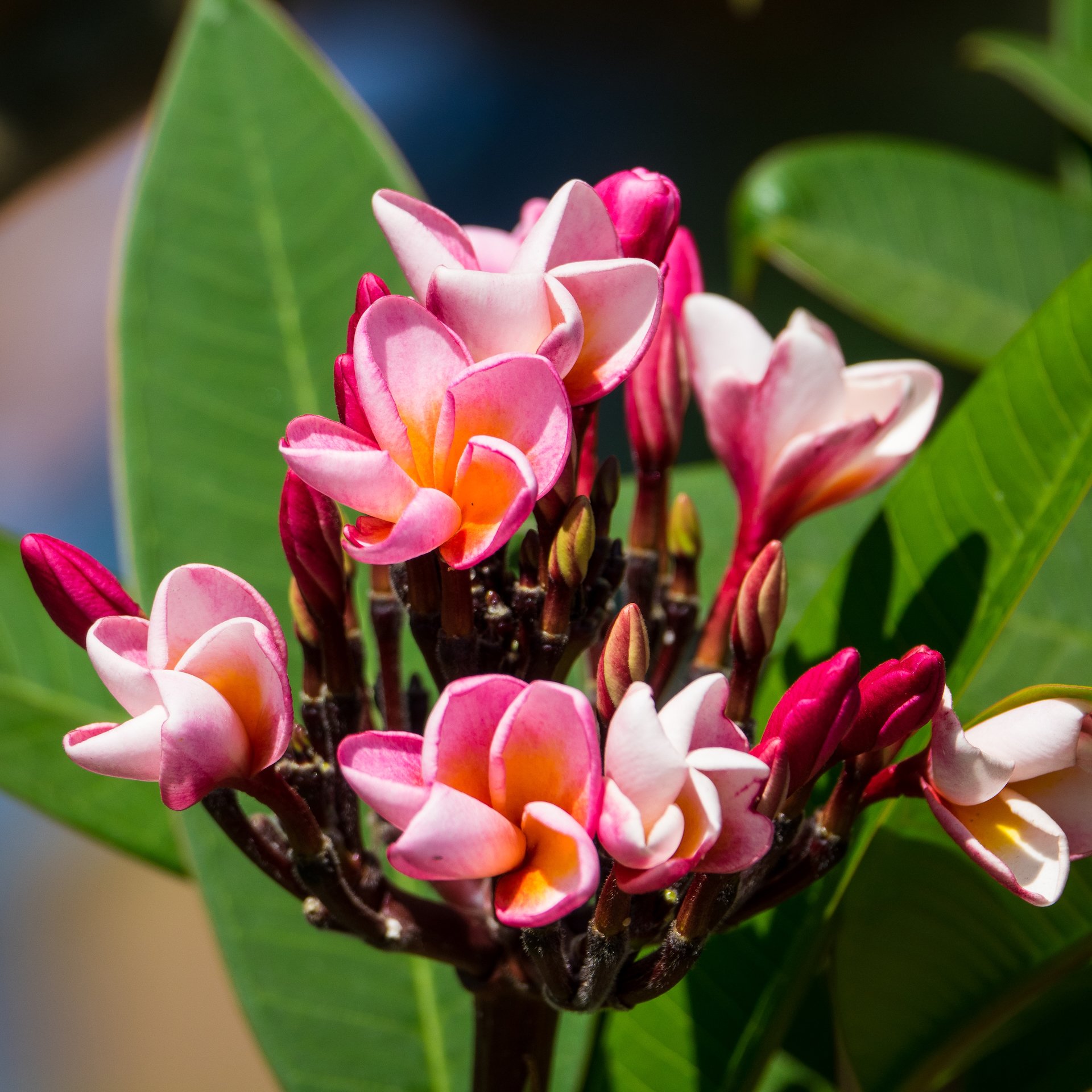
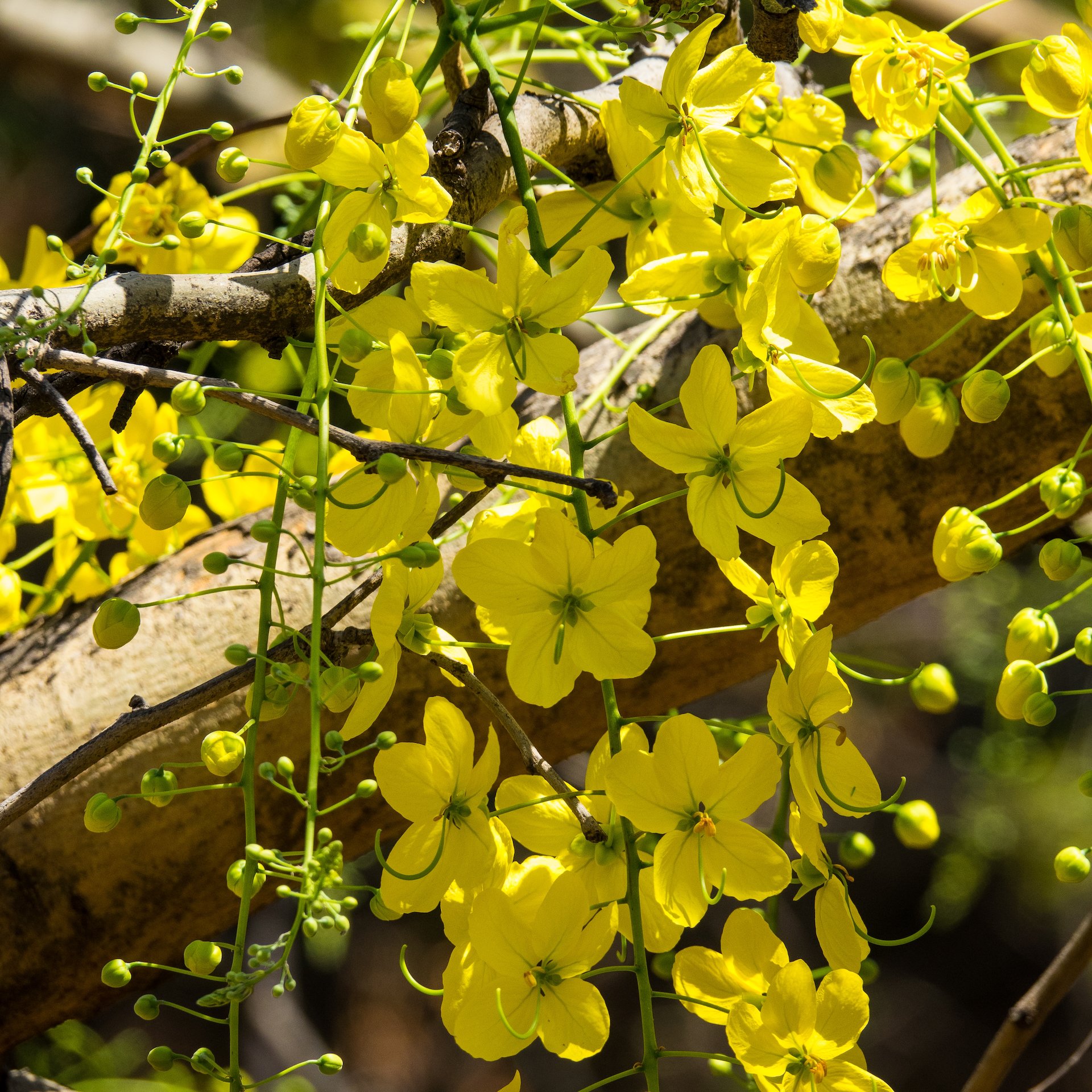
Inside the courtyard, there was this amazing plumeria tree that was in full bloom.
Shaniwar Wada also has a massive palace complex. It was a magnificent structure with several buildings, courtyards, and gardens. The palace was adorned with beautiful paintings, sculptures, and other works of art. It was also equipped with modern amenities such as fountains, water channels, and a sophisticated drainage system. Sadly, almost none of it remains.
Looking down on the inside of the palace from up on the curtain walls.
In 1828, a massive fire destroyed most of the palace complex. Today, only the massive walls and the ruins of the palace remain. Throughout the grounds there are still many beautiful trees and flowers, and you can walk around the whole our curtain wall, allowing you to explore a lot. Despite its ruined state, Shaniwar Wada remains a popular tourist attraction and a symbol of the rich cultural heritage of Pune and the Maratha Empire. It was very busy the whole time we were there and was mainly local people rather than tourists.
A view from the other side of the complex.
As we explored the ruins, our local friends filled in some of the details about the place and did a good job helping us to understand the historical context. Beyond the details of the palace itself, there were a couple of additional interesting things (probably more to me than the rest of the group) that happened during our visit.
The first was quite hilarious – apparently many of these people don’t see a lot of foreigners. This kept occurring over the course of the weekend, but earl on I had a family come up to me to want me to take a picture with them. I had to shake hands with them while they took pictures. I have no idea why, but it seemed to make them very happy. It was pretty hilarious. And it happened to a bunch of us numerous times over the weekend. We were celebrities!
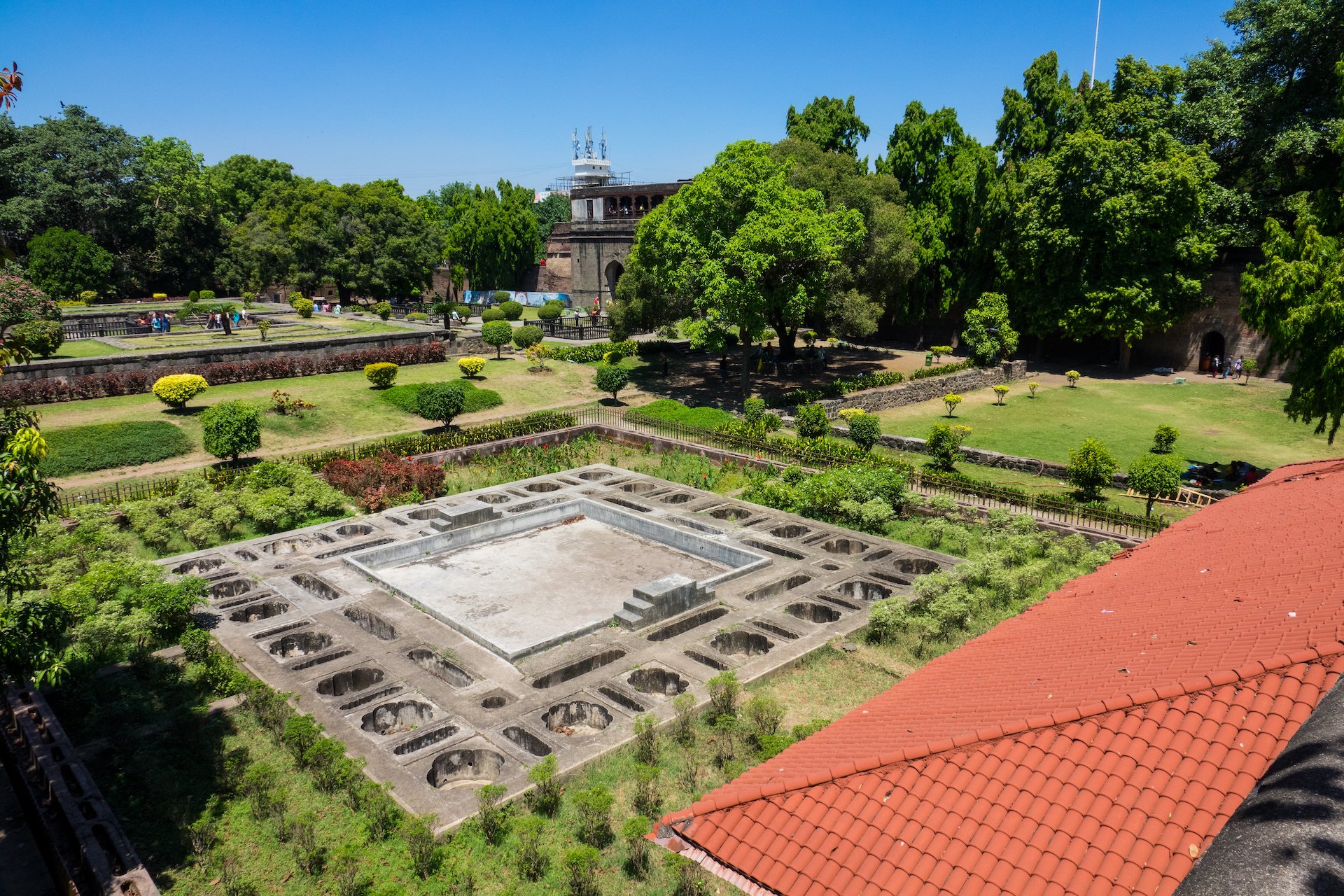
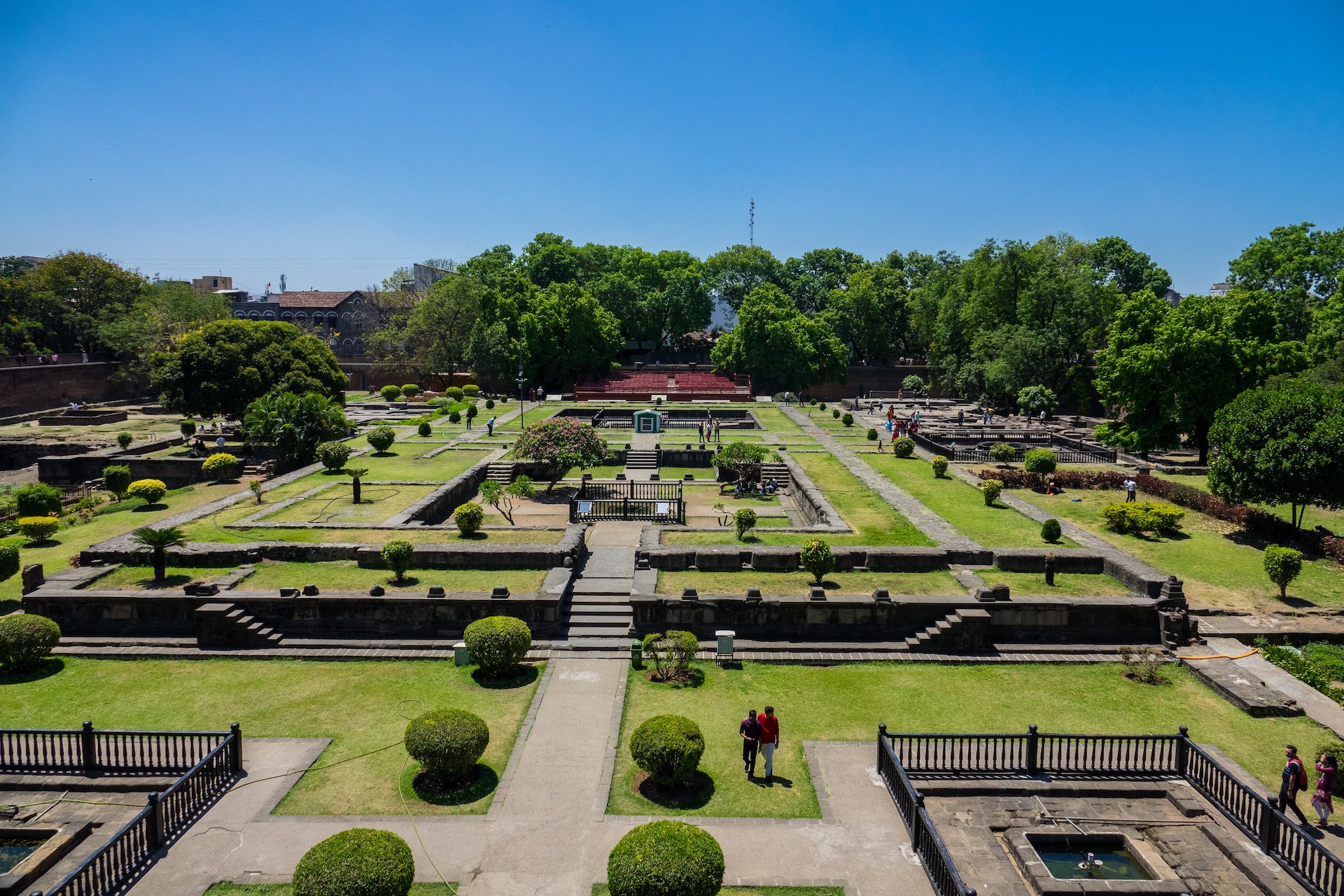

The second was that I got some great close-up shots of the kites (local birds of prey) that we were seeing all over the city. A few of them swooped down into the trees over the fort. And some of them had caught prey that they were eating. It was very cool.
Some of the kites dropped down into the trees near us, feasting on… something
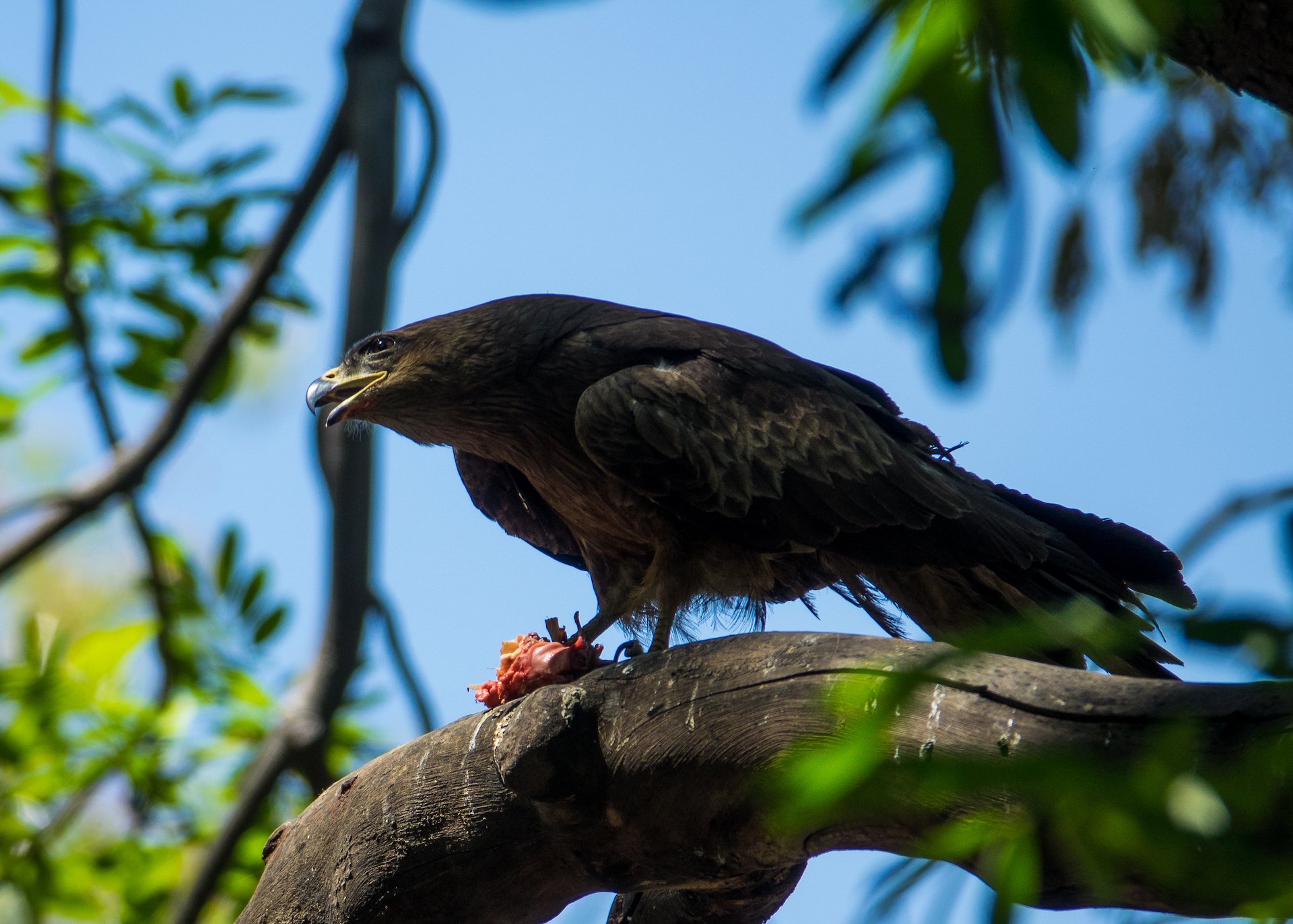
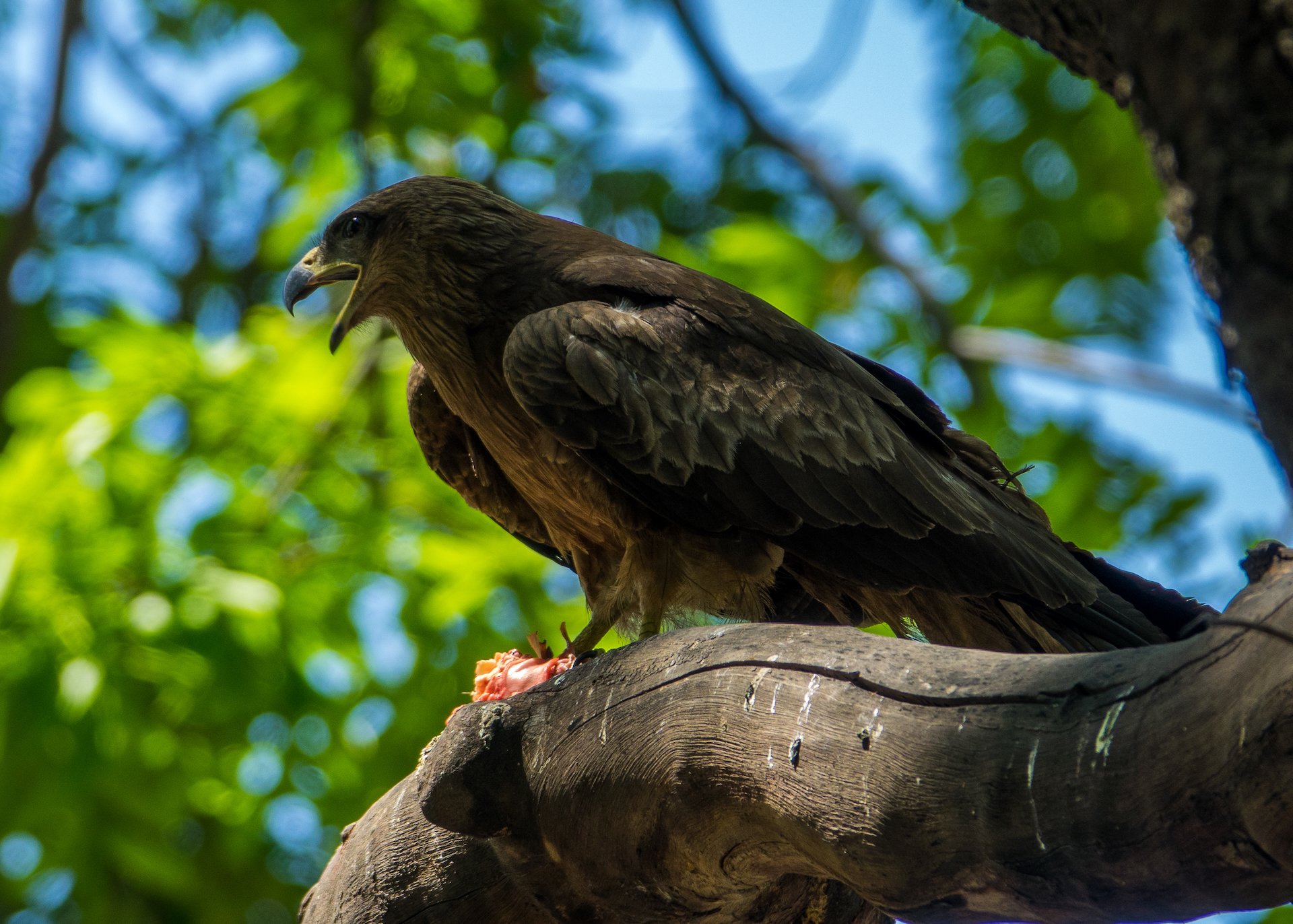

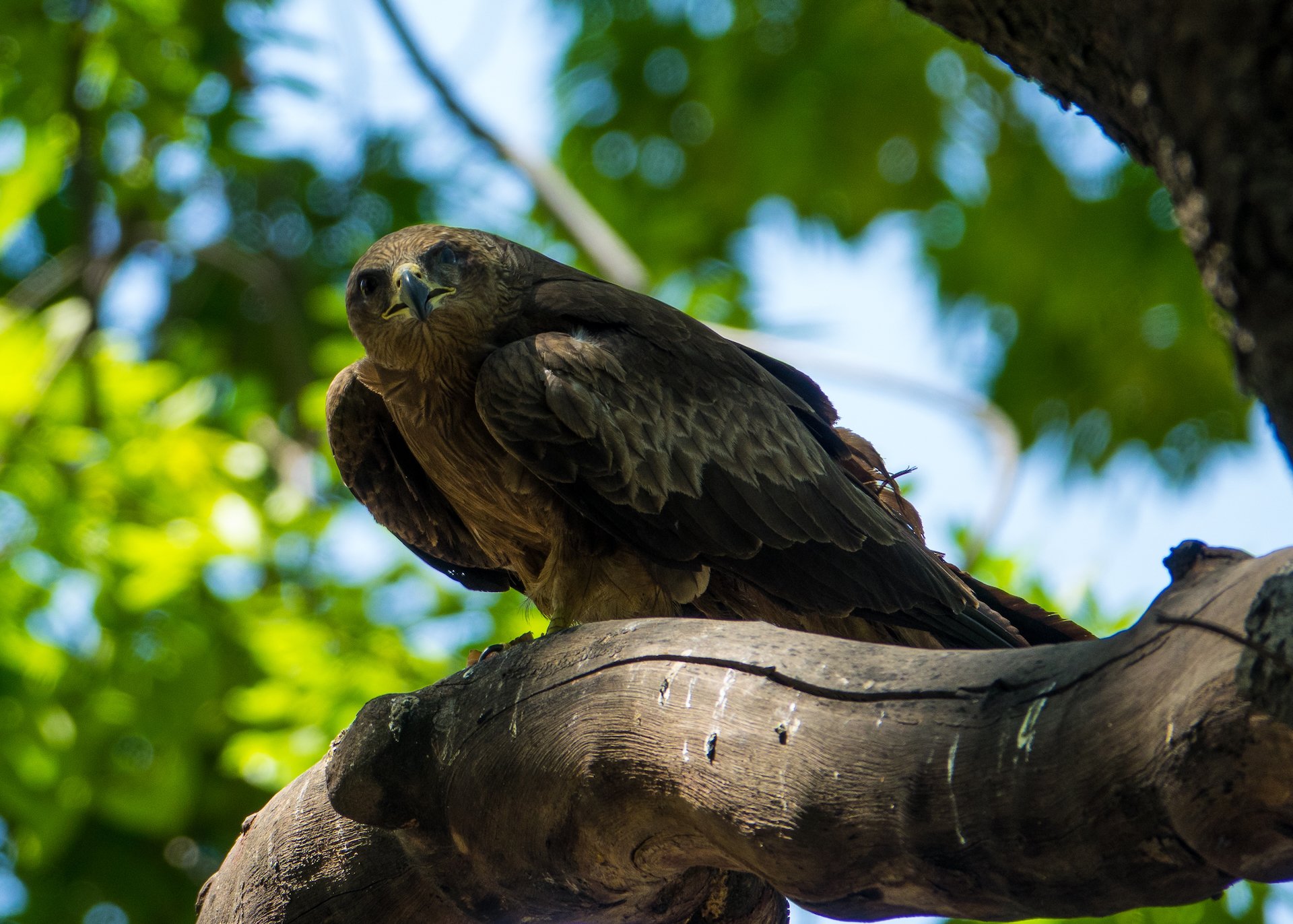
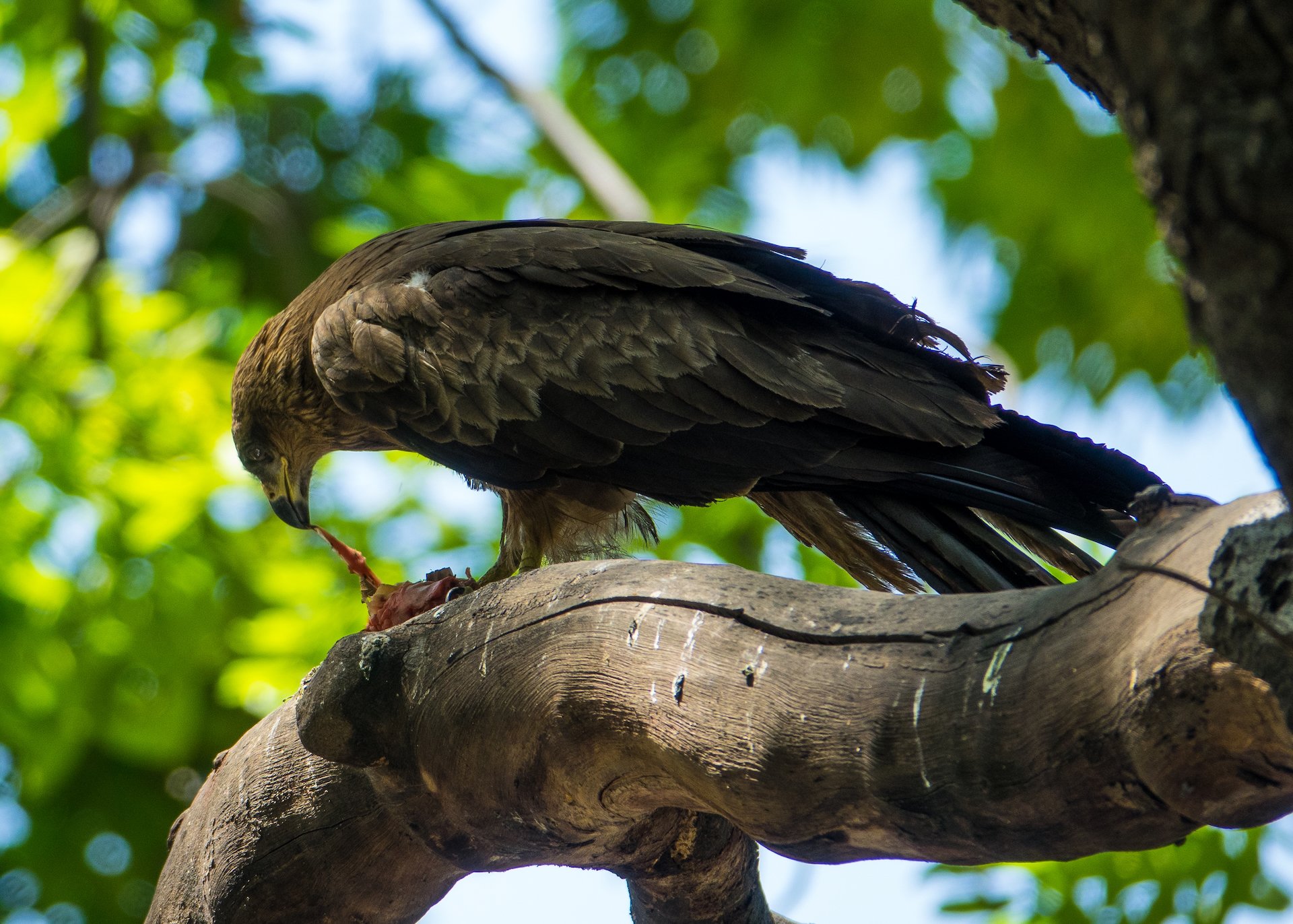

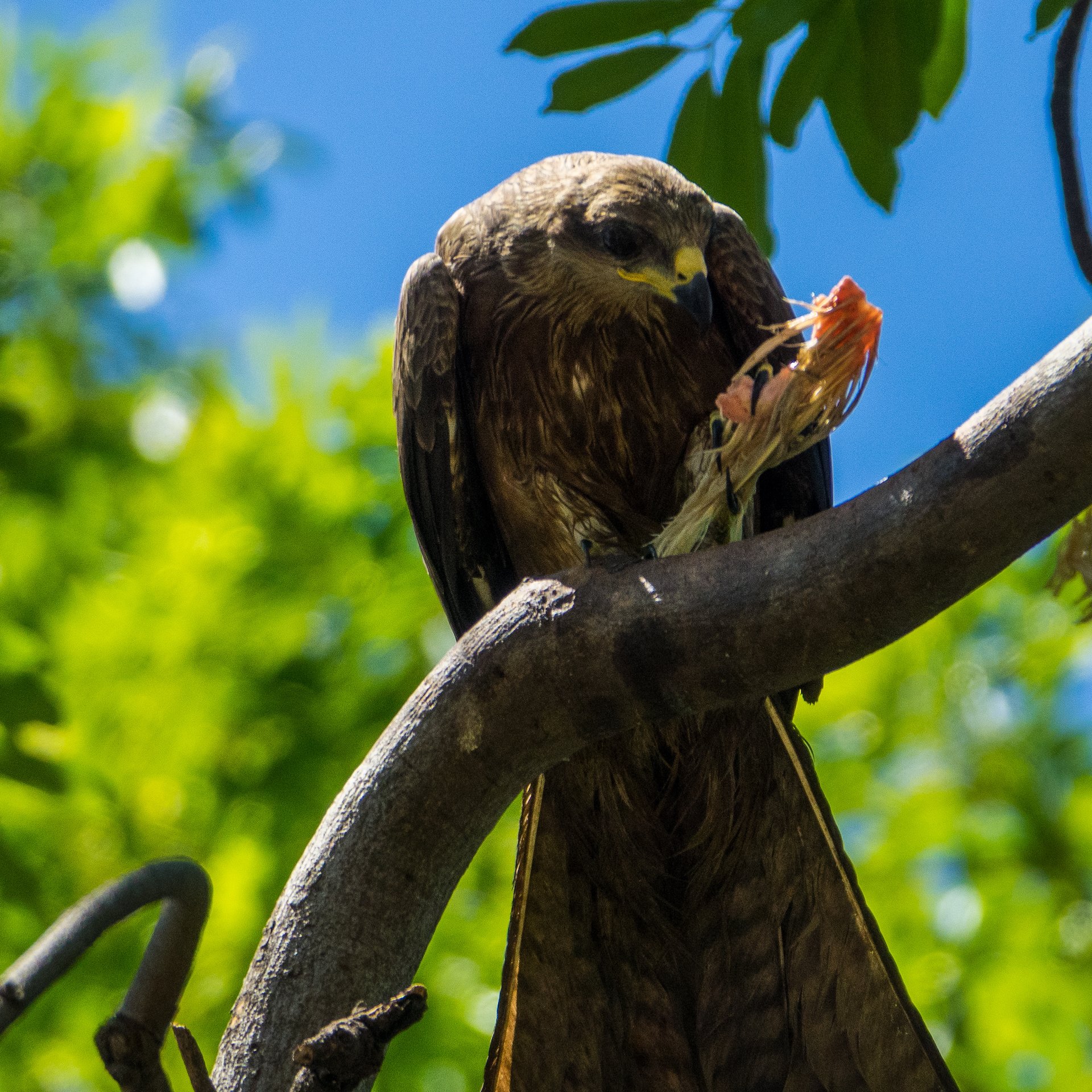
Finally, at one corner of the palace was a huge banyan tree. It did not have a lot of room to spread out, so it was just getting massive. There was a kite nest up in one branch, and you could see where the shoots were creating multiple “trunks” for the tree. It was huge and beautiful.
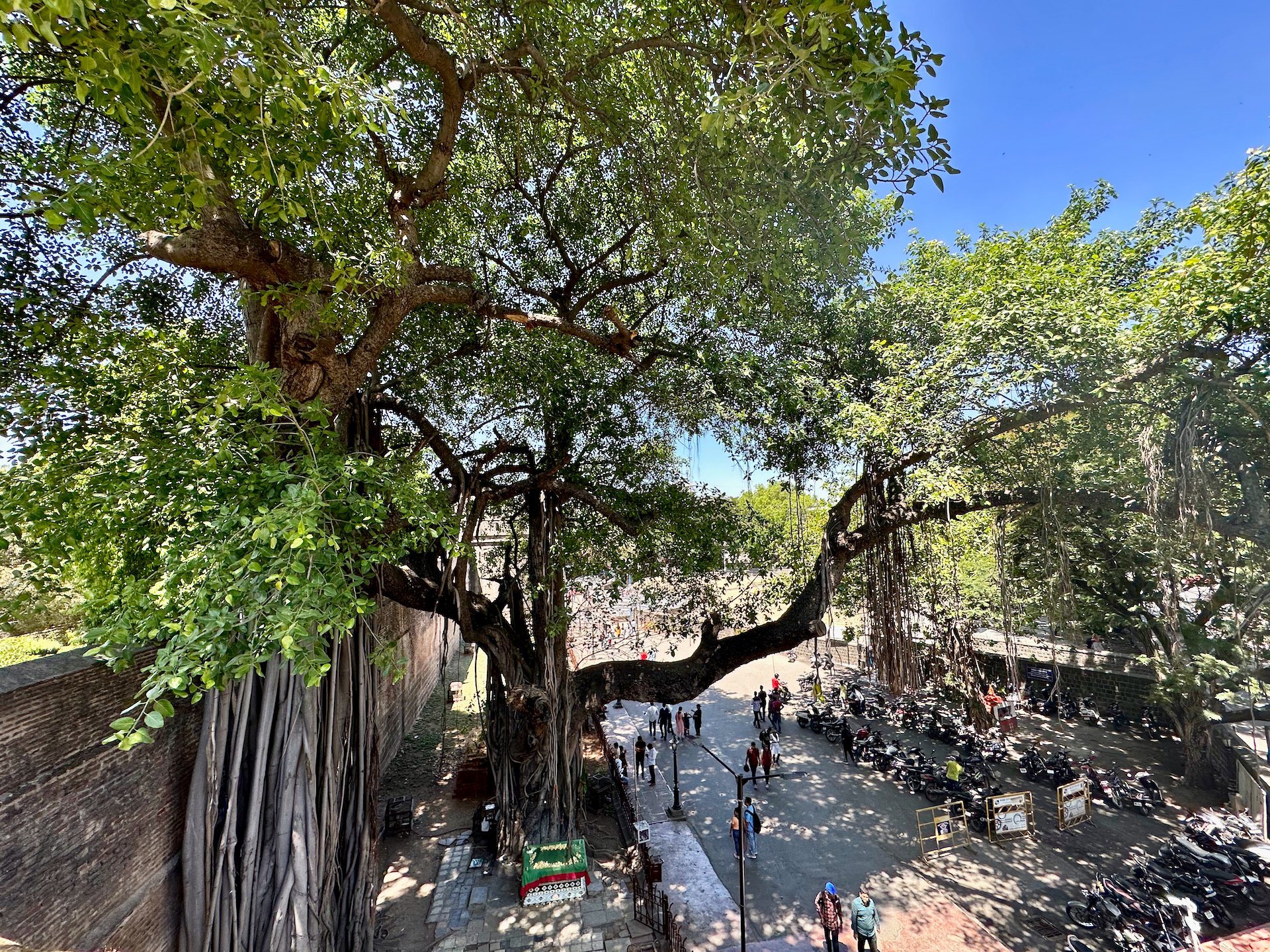
The fort itself is located pretty much in the center of the city and you could really tell how much older this part of the city is from where our hotel is located. The buildings are much different.
You could see how much older the building in this part of town.
Before we headed to our next destination, they took us across the road (which is much harder than it sounds…) to see the Lal Mahal. The palace was built in 1630 by Shahaji Bhosale, the father of the Maratha warrior king Shivaji Maharaj. Lal Mahal is an important landmark of Pune and a popular tourist attraction.
Looking over to the king’s palace from the wall of the fort.
This building was a fairly recent re-creation – the original Lal Mahal was destroyed during the invasion of Pune by the Mughal emperor Aurangzeb. The palace was rebuilt in the early 20th century, and today it stands as a symbol of the rich cultural heritage of Pune and the Maratha Empire. Lal Mahal also has a museum that showcases the history and culture of the Maratha Empire. The museum has a collection of artifacts, paintings, and sculptures that provide visitors with a fascinating insight into the local history. We explored it for a bit before heading to our next stop.
Raja Dinkar Kelkar Museum
The Raja Dinkar Kelkar Museum is a unique museum that houses an extensive collection of Indian artifacts, handicrafts, and artwork, which is a reflection of the rich cultural heritage of India. The Raja Dinkar Kelkar Museum has a vast collection of over 21,000 artifacts. The collection includes traditional Indian paintings, sculptures, metalwork, textiles, and jewelry. The artifacts are from different parts of India and represent various periods of Indian history.
One of the most beautiful statues in the museum. This is Ganesha who is one of the best-known and most worshipped deities in the Hindu pantheon and is the Supreme God in Ganapatya sect.
The museum building itself is an architectural marvel. It is a three-story building built in the traditional Rajasthani style of architecture. The building has intricately carved wooden doors, balconies, and windows. The building also has a beautiful courtyard with a fountain and a garden.
We spent a good couple of hours looking around the collection. There were some very interesting items to see, some were things I had never seen in other museums I’ve been to around the world.

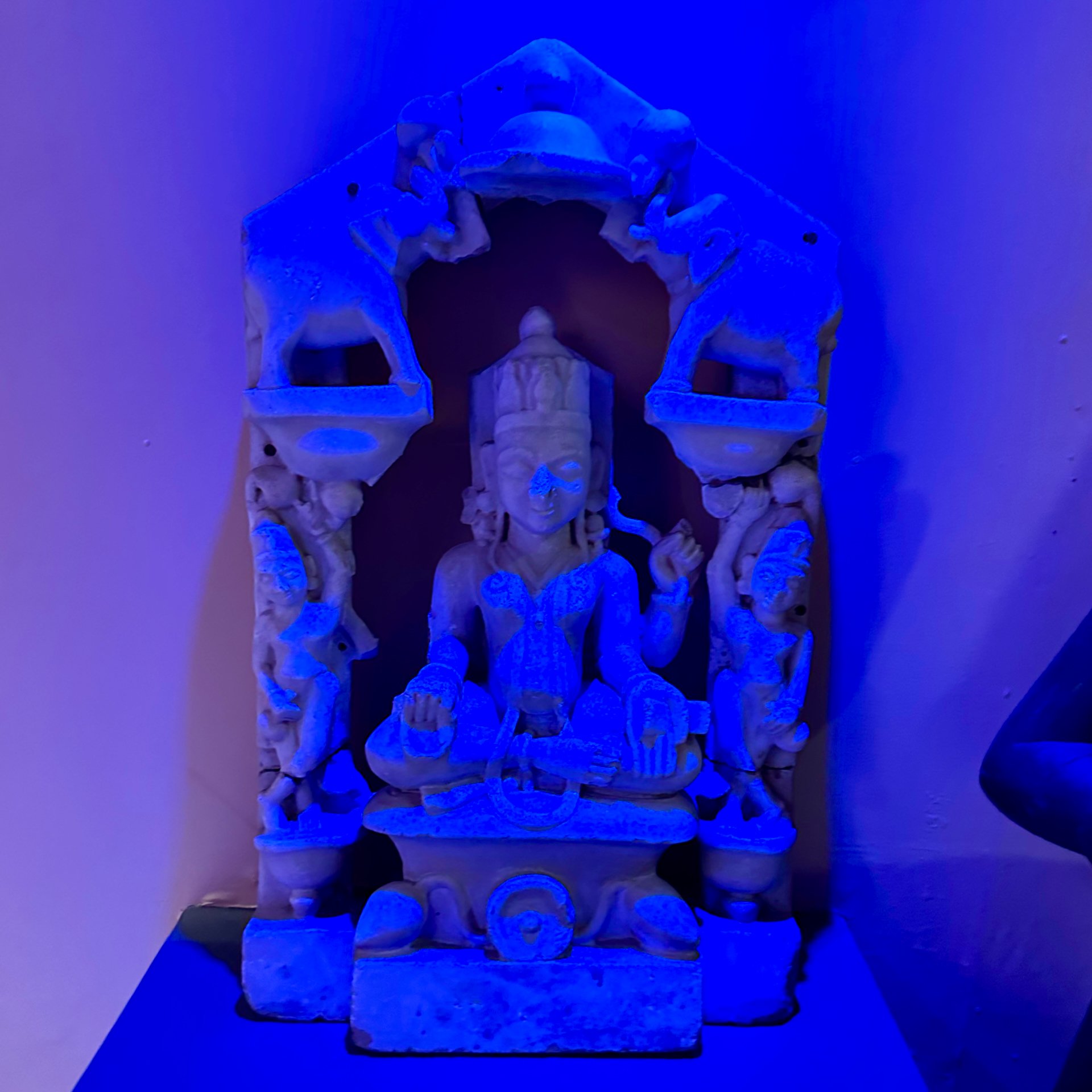
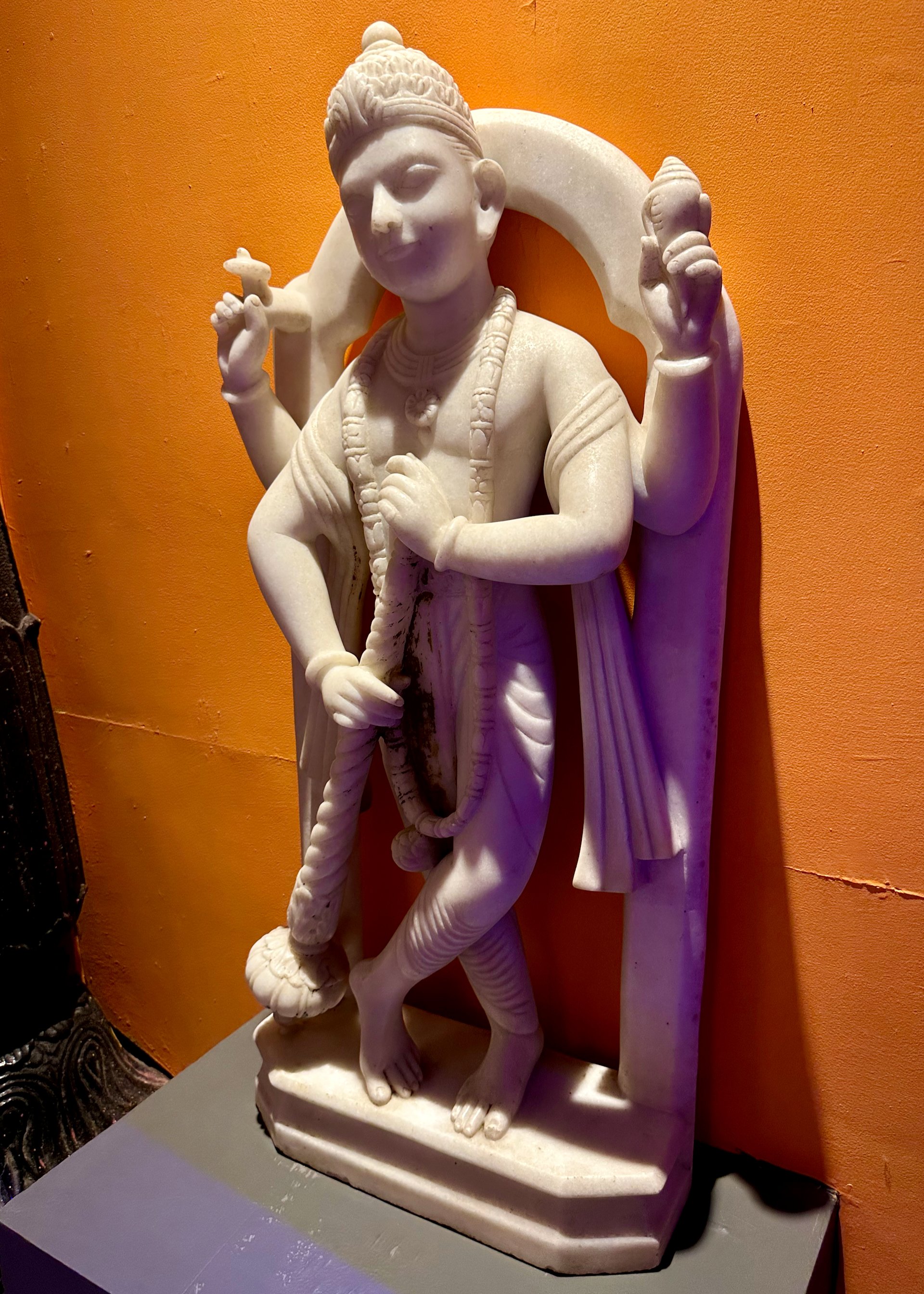
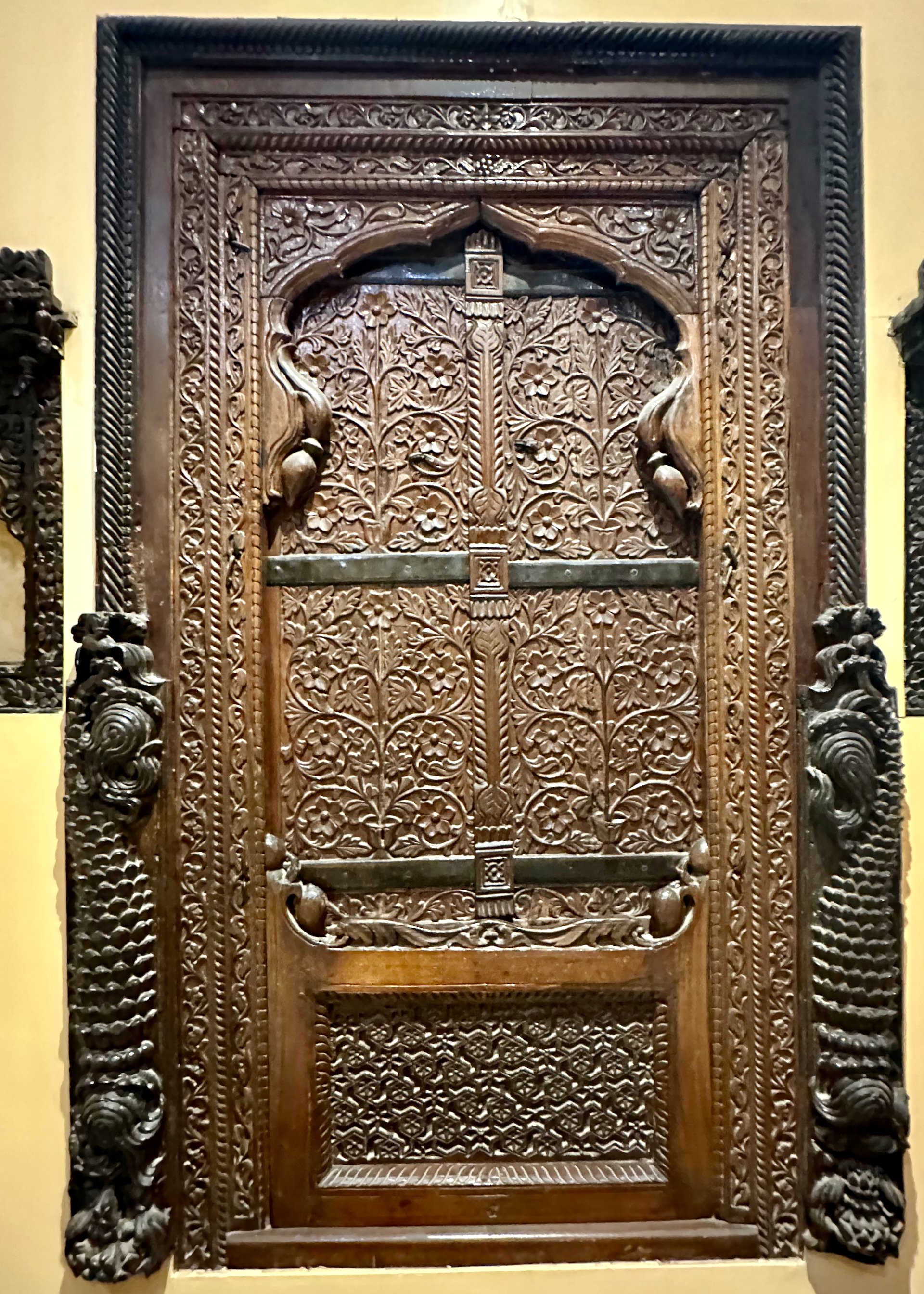
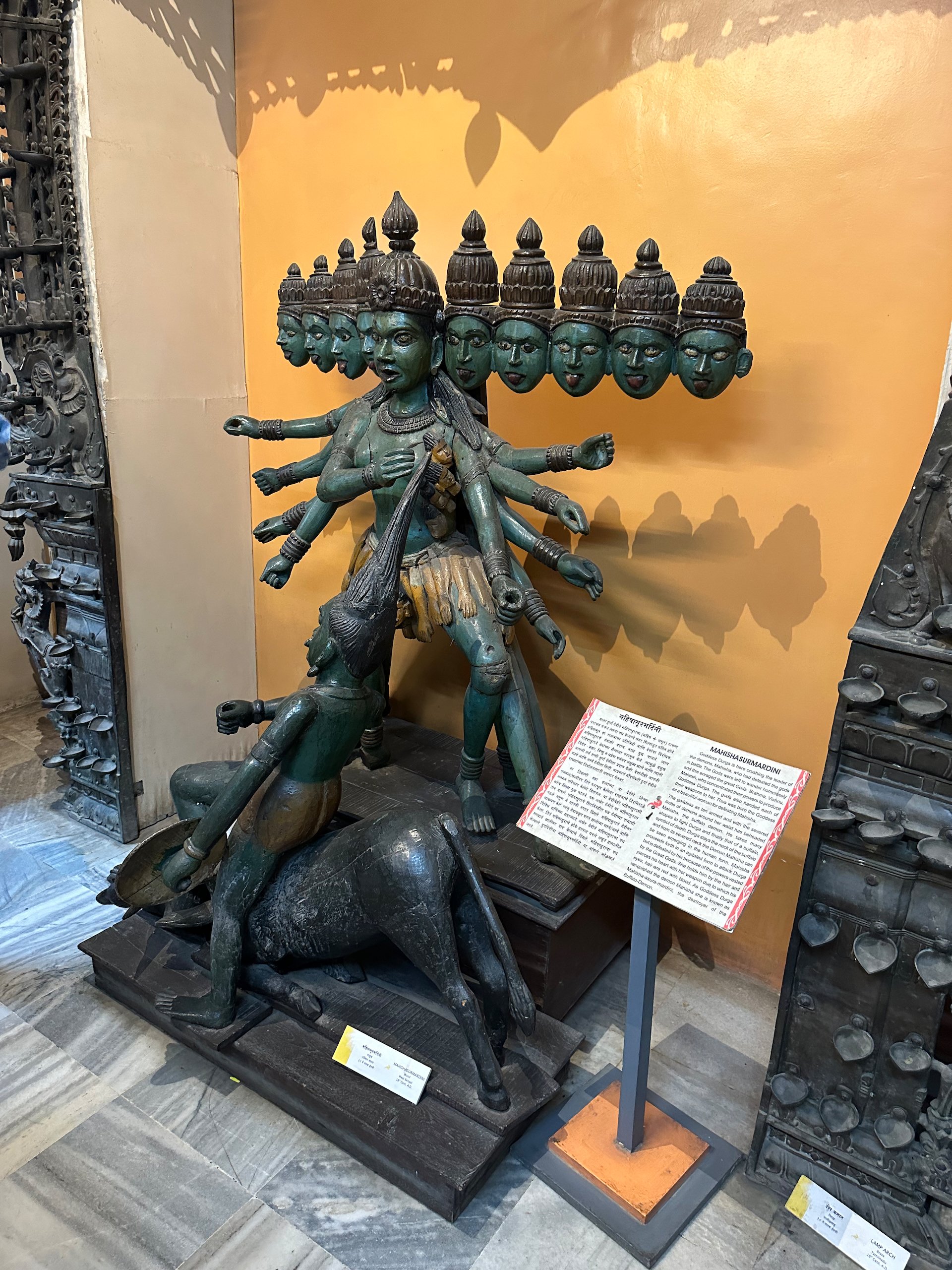
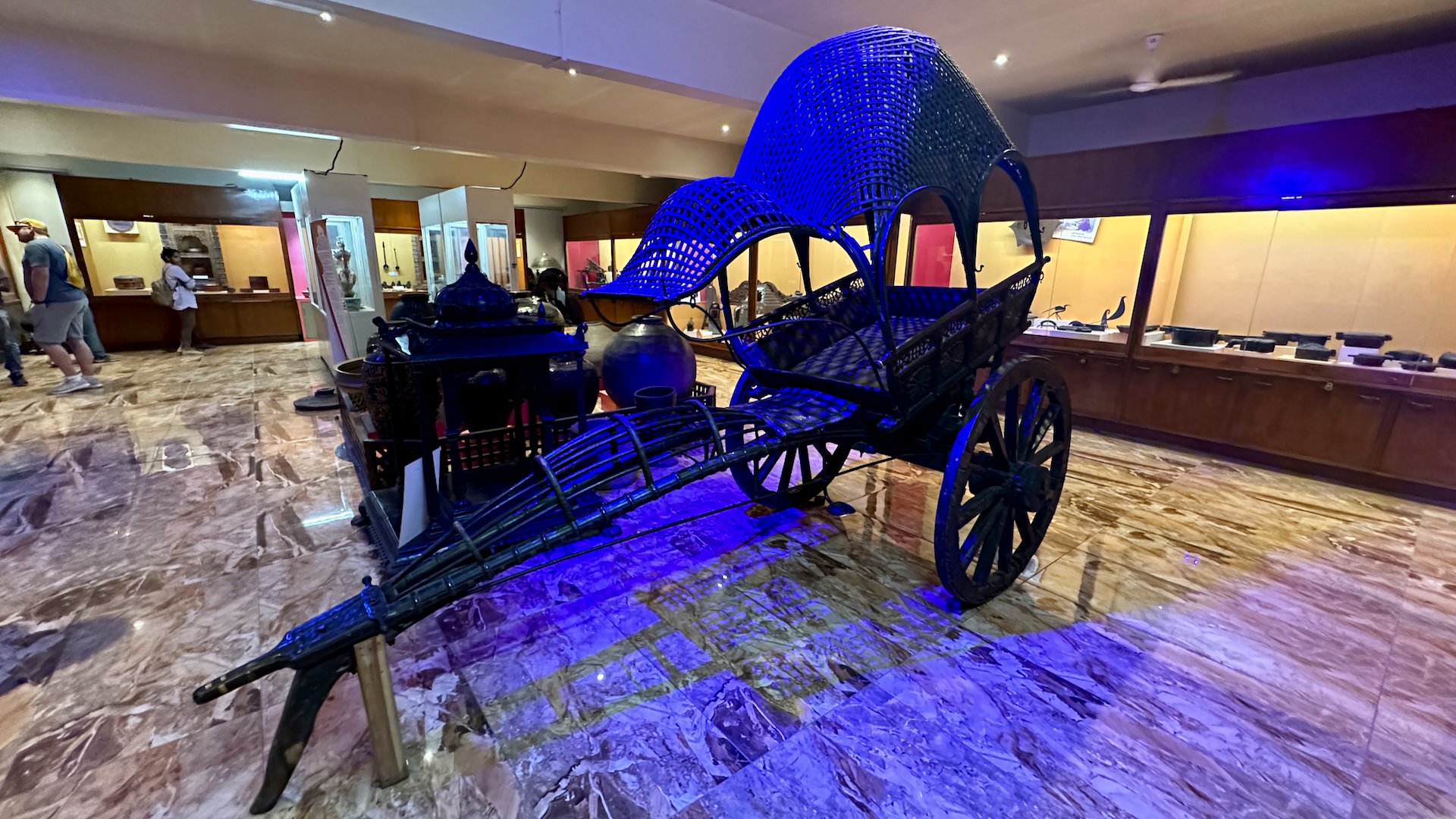
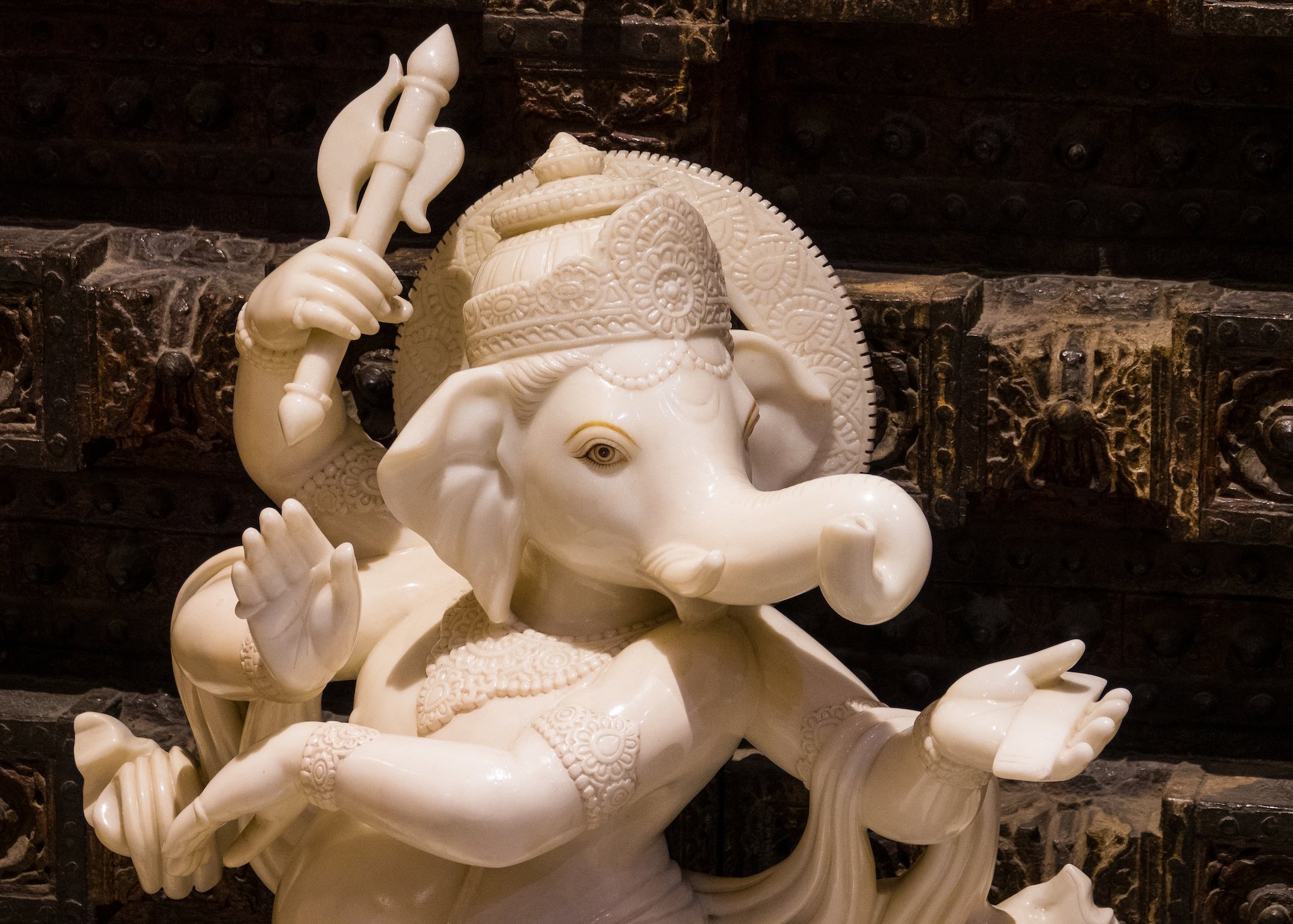

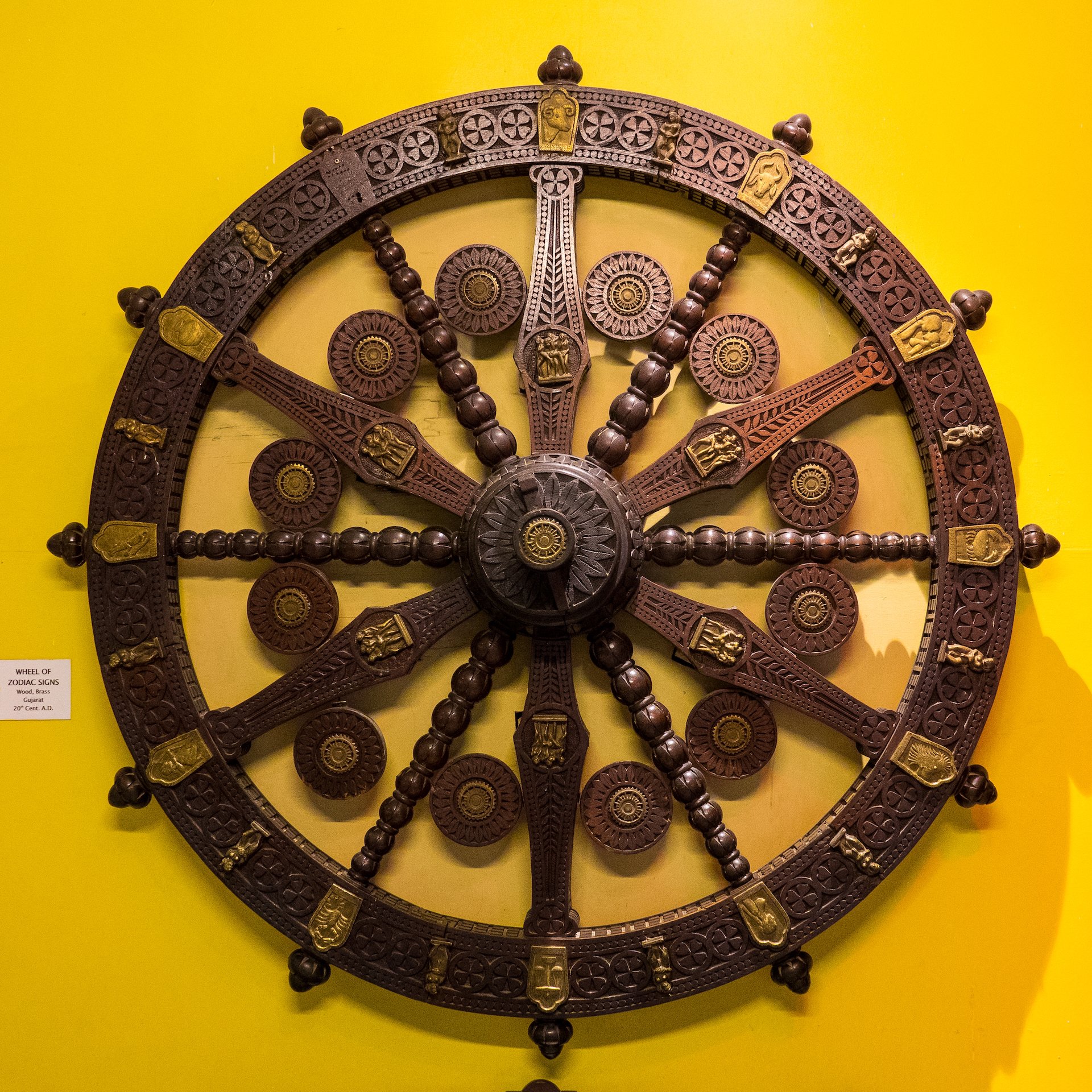
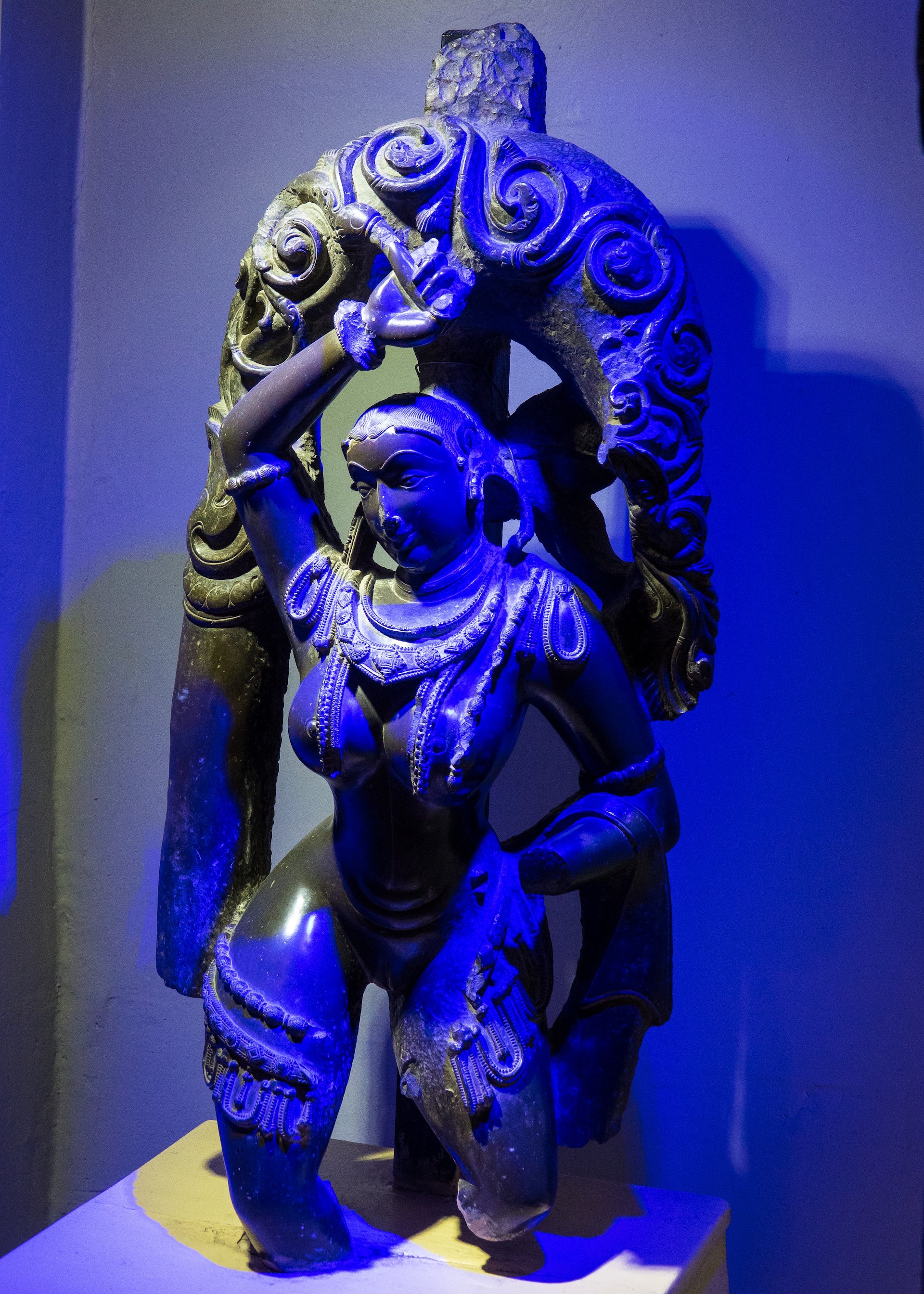
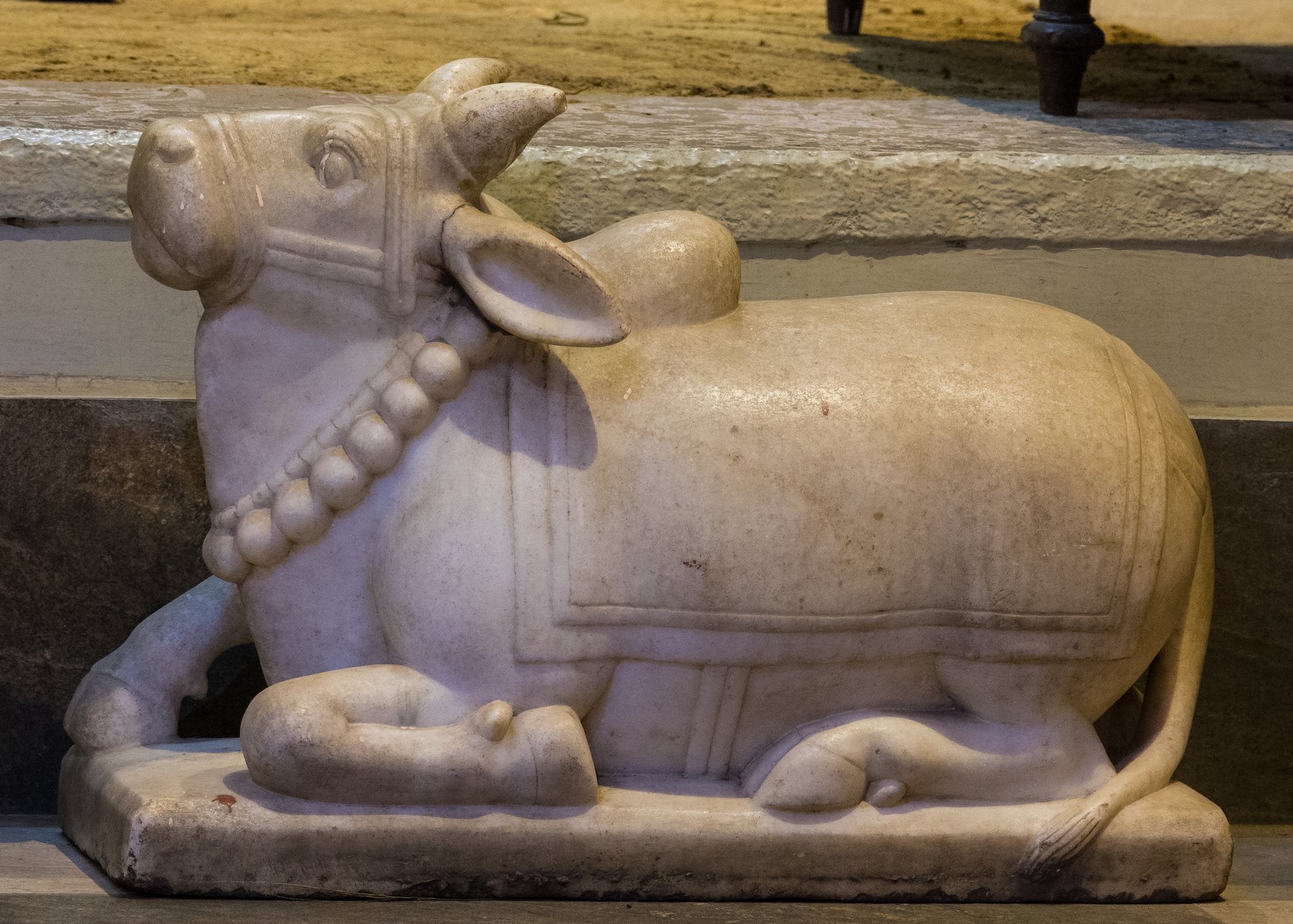
By this point, we were well past lunch and all of us were hungry. We ended up at the same restaurant that we went for lunch at one day during the week! That was pretty funny – Erica and I were experts, but the rest of the group had not been before. Lunch was delicious, but once again I was overly full. That was a common occurrence over the course of my two weeks in Pune.
Our excellent lunch.
After lunch was over, different people had different objectives, but it all centered around doing some shopping. At this point I made a huge mistake – I could have easily walked back to the hotel from where we were, but instead, I went with the group. This was both good and bad.
The market was crazy and jammed with people. Everything I expected from an Indian street market!
Once we got to the shopping district (or one of them anyway) our group split up into two. A few of us ended up with Mukesh and we ended up in this huge, open-air market. It covers dozens of streets – we saw maybe 2-3 of them and was jammed with people. It was what I envisioned in my mind when I think of an Indian street market. We pushed our way through, trying not to get run over by the scooters and motorcycles that also felt they could co-exist on the crowded streets. We stopped in a few stores to find things for different people. Eventually it was a bit too much and we headed out of the market. On the edge of the market the group went into a sweet shop, and I continued to wander about.

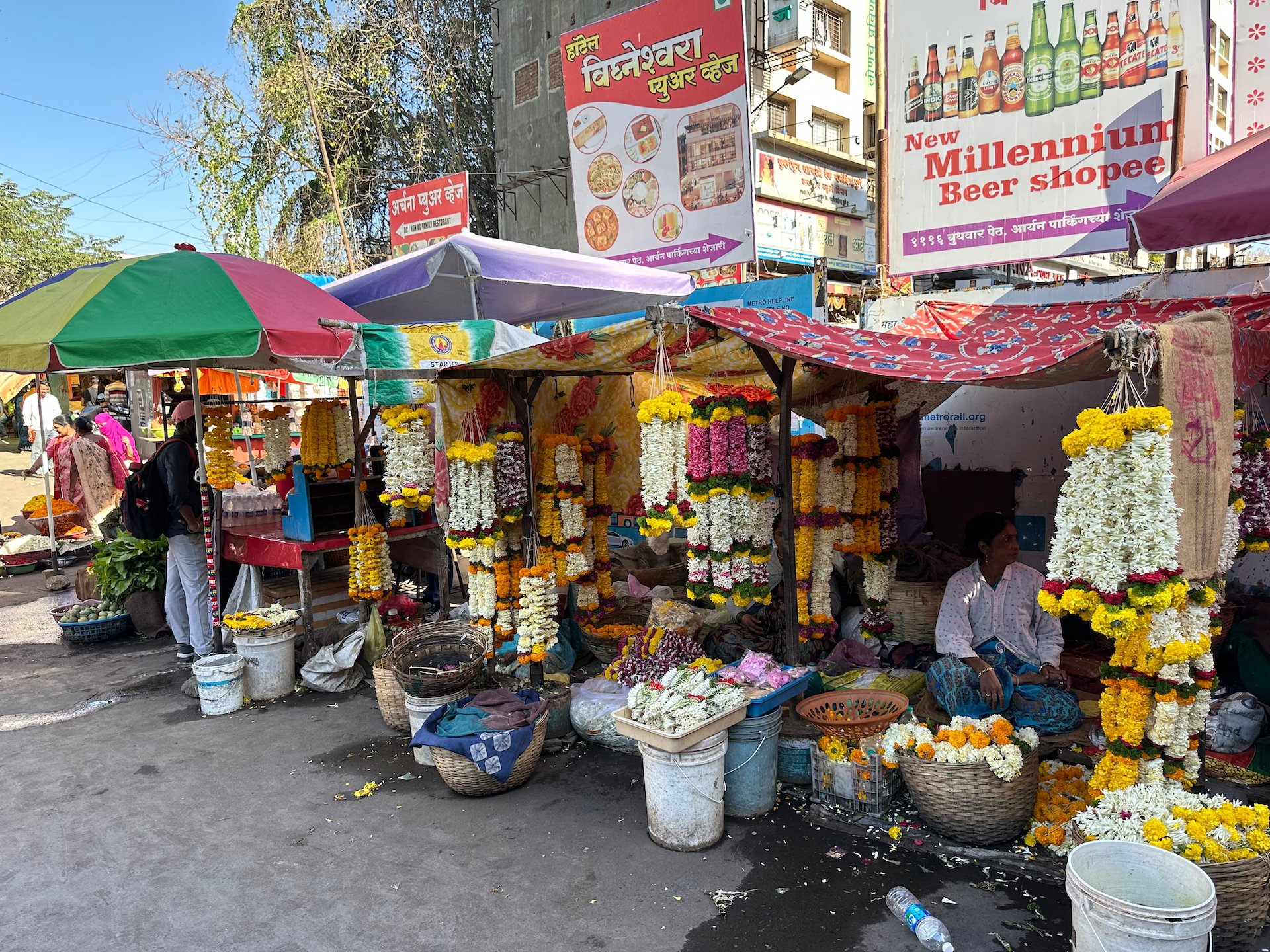
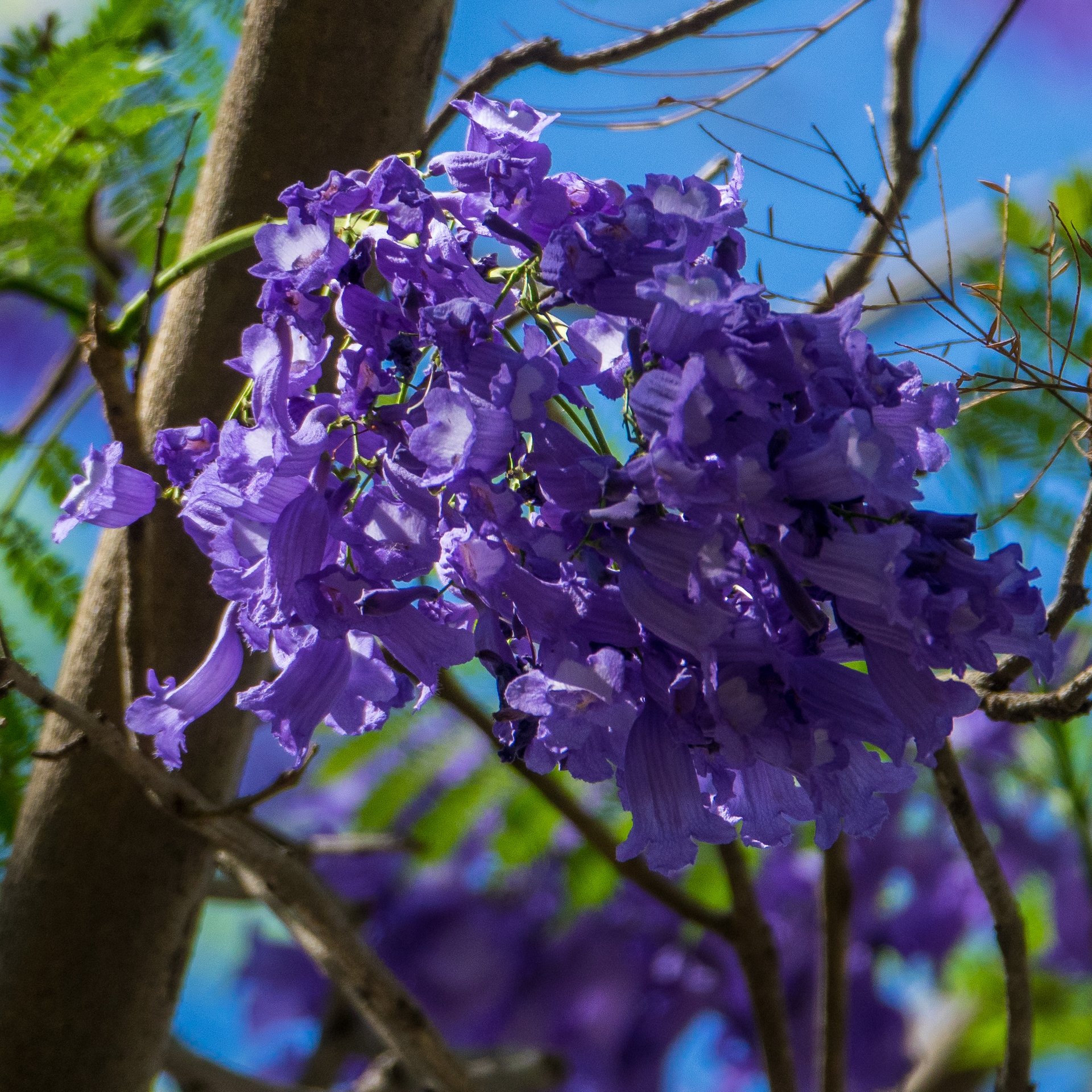
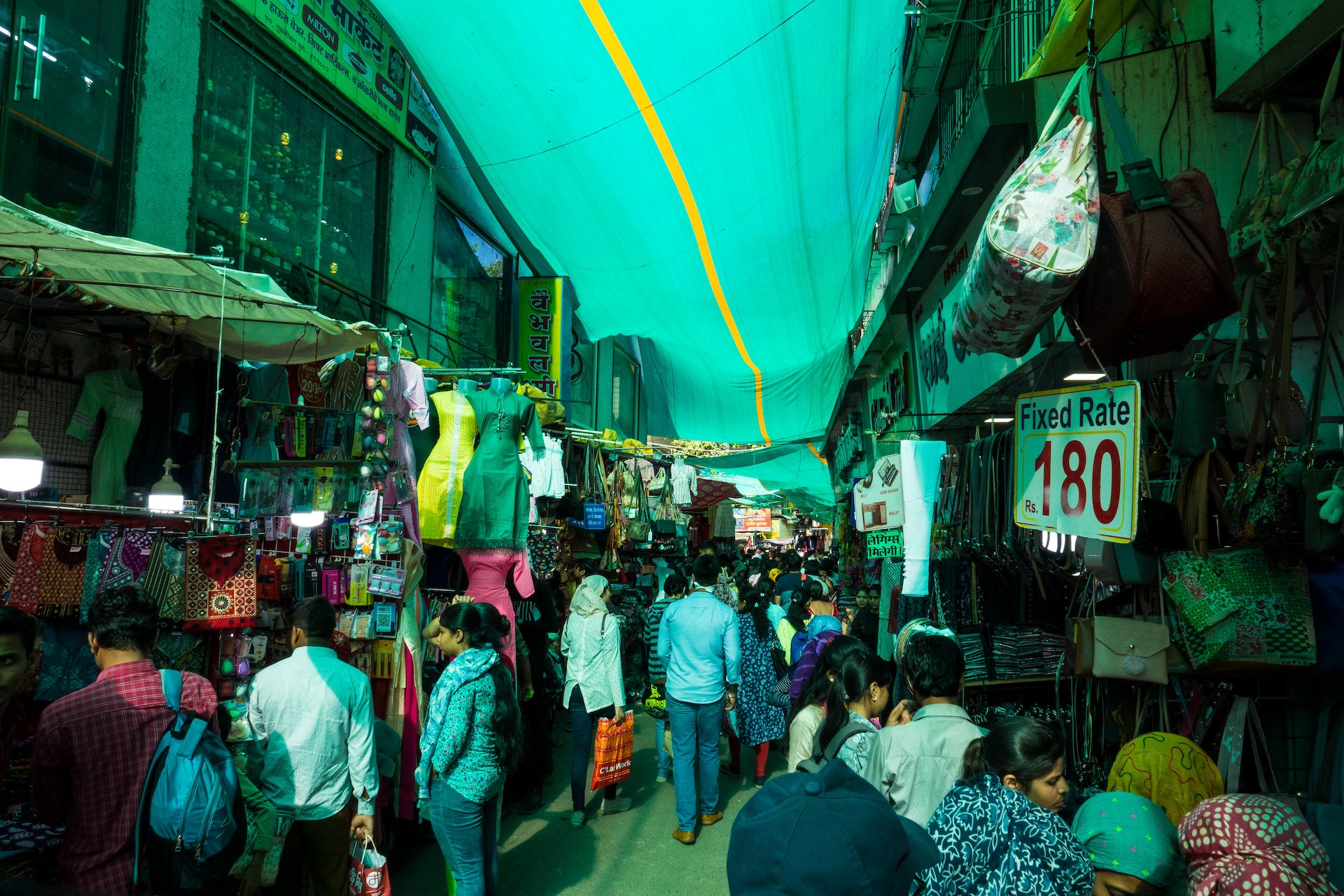
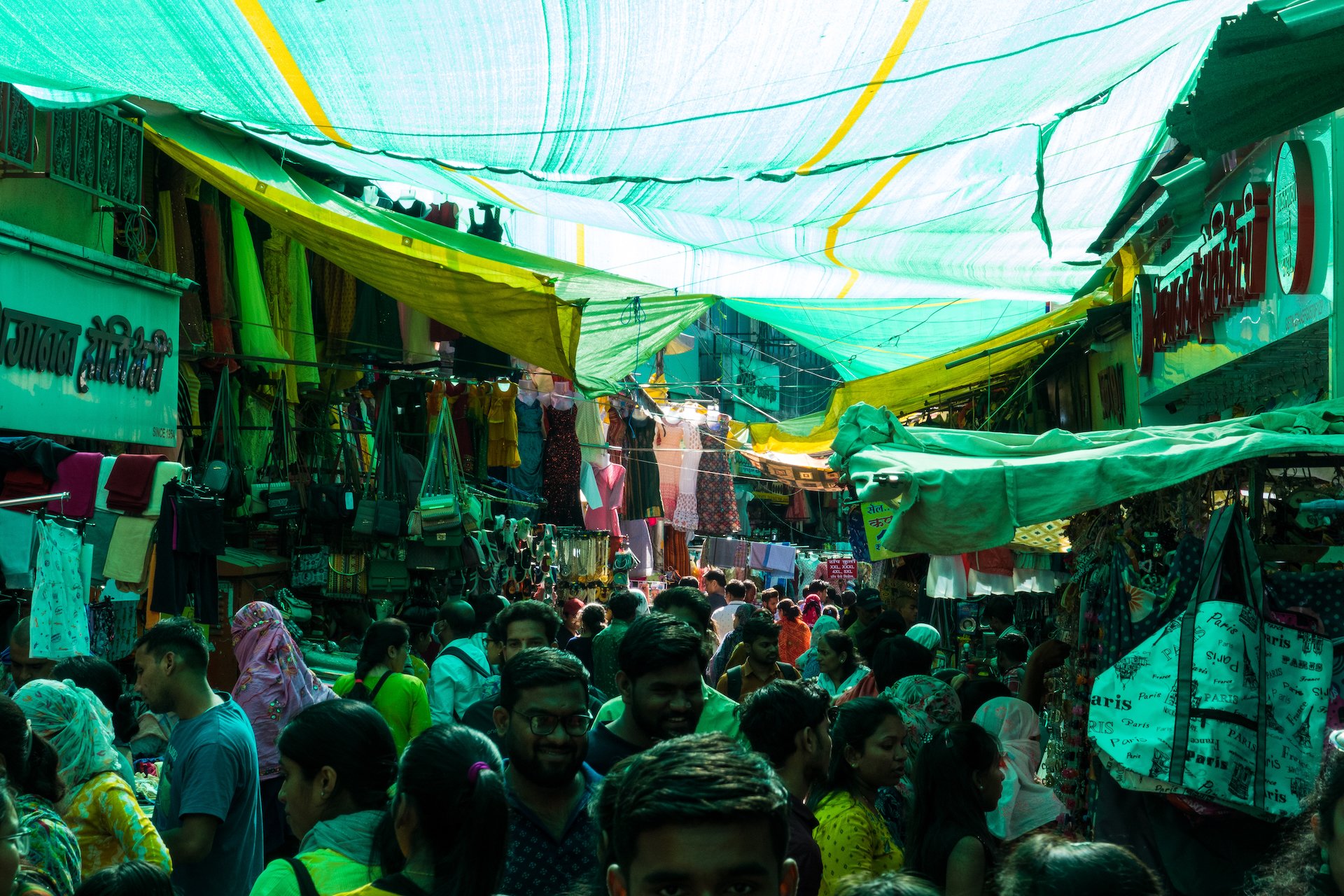
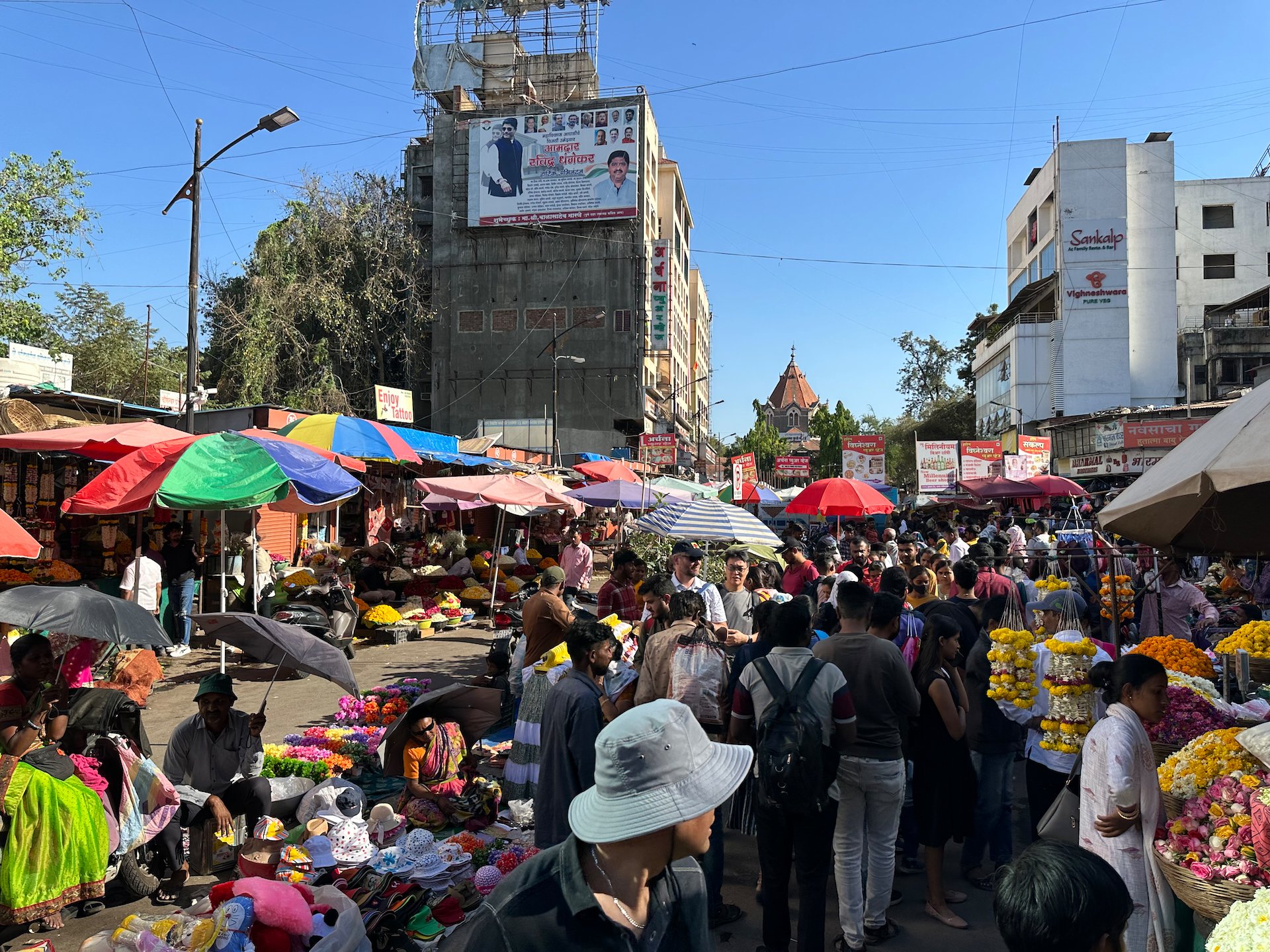
On the way into the market, there were lots of great vendors - these figs looked amazing!
There was a small temple right inside the market. It was interesting to see people walk up to it and do short prayers or drop off flowers.
This section of the market had a great collection of flower vendors. The area smelled amazing and there was so much color and vibrancy to the scene. I wandered around for a while, until the group was done.
The flower market was amazing!
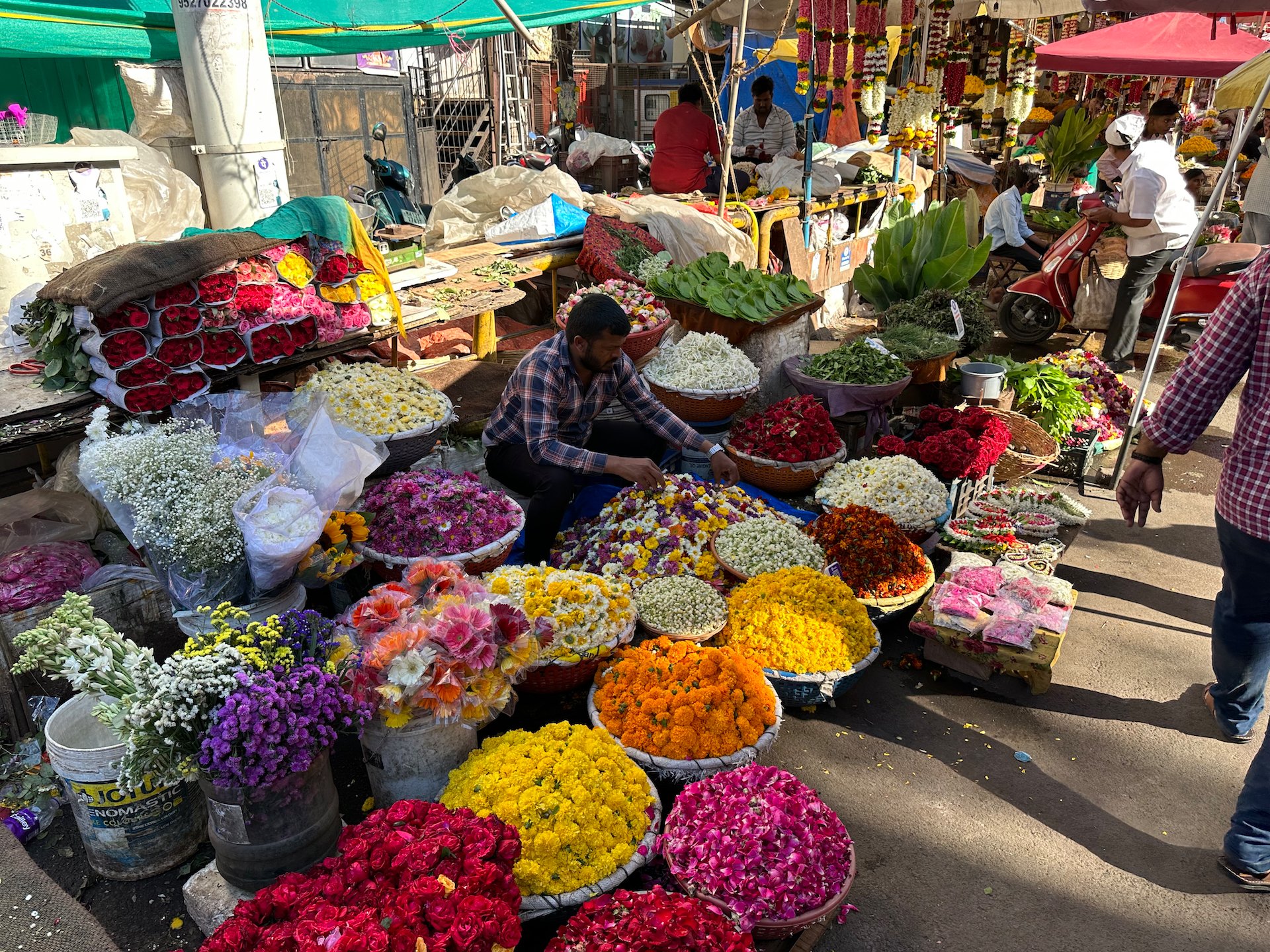
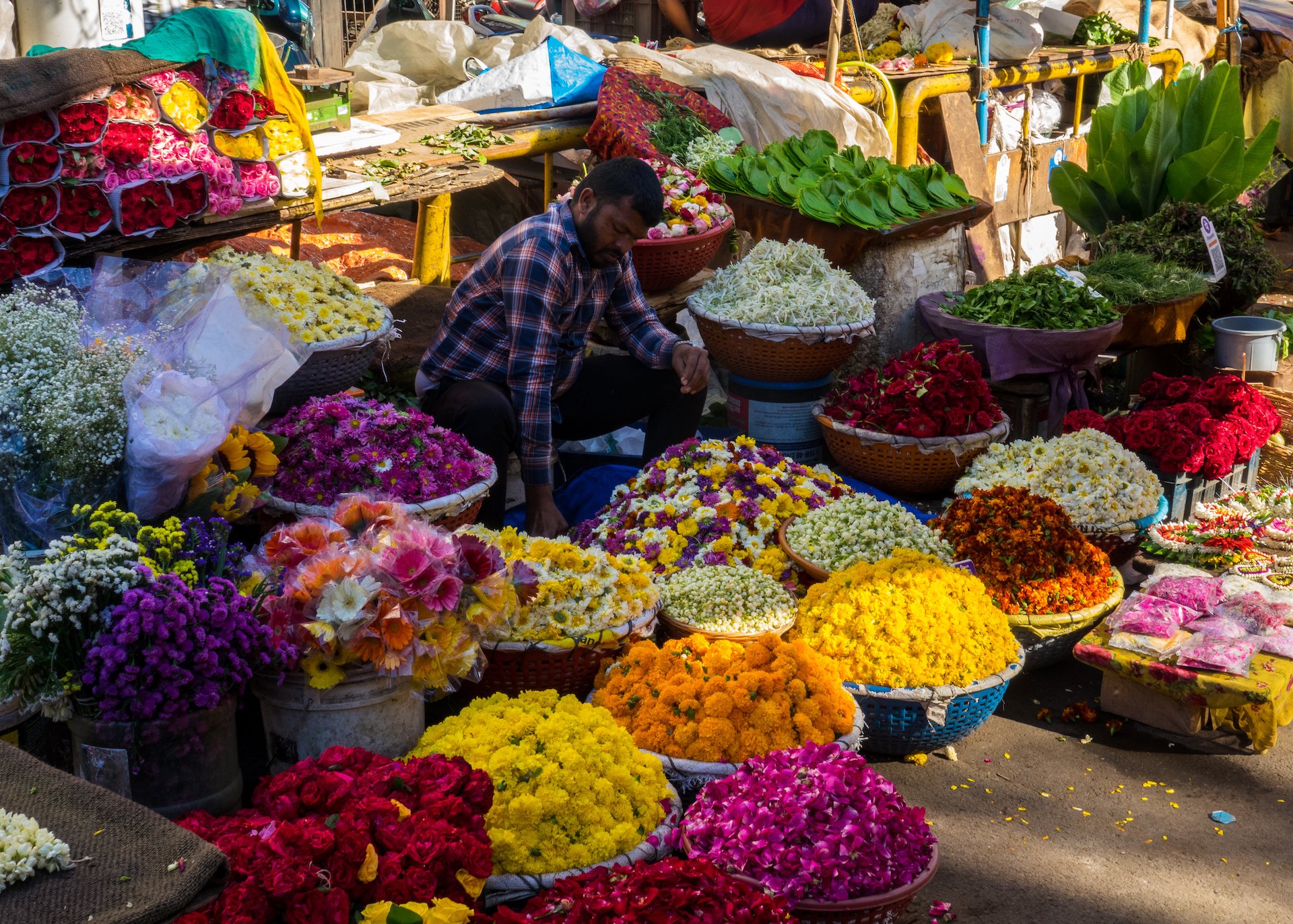
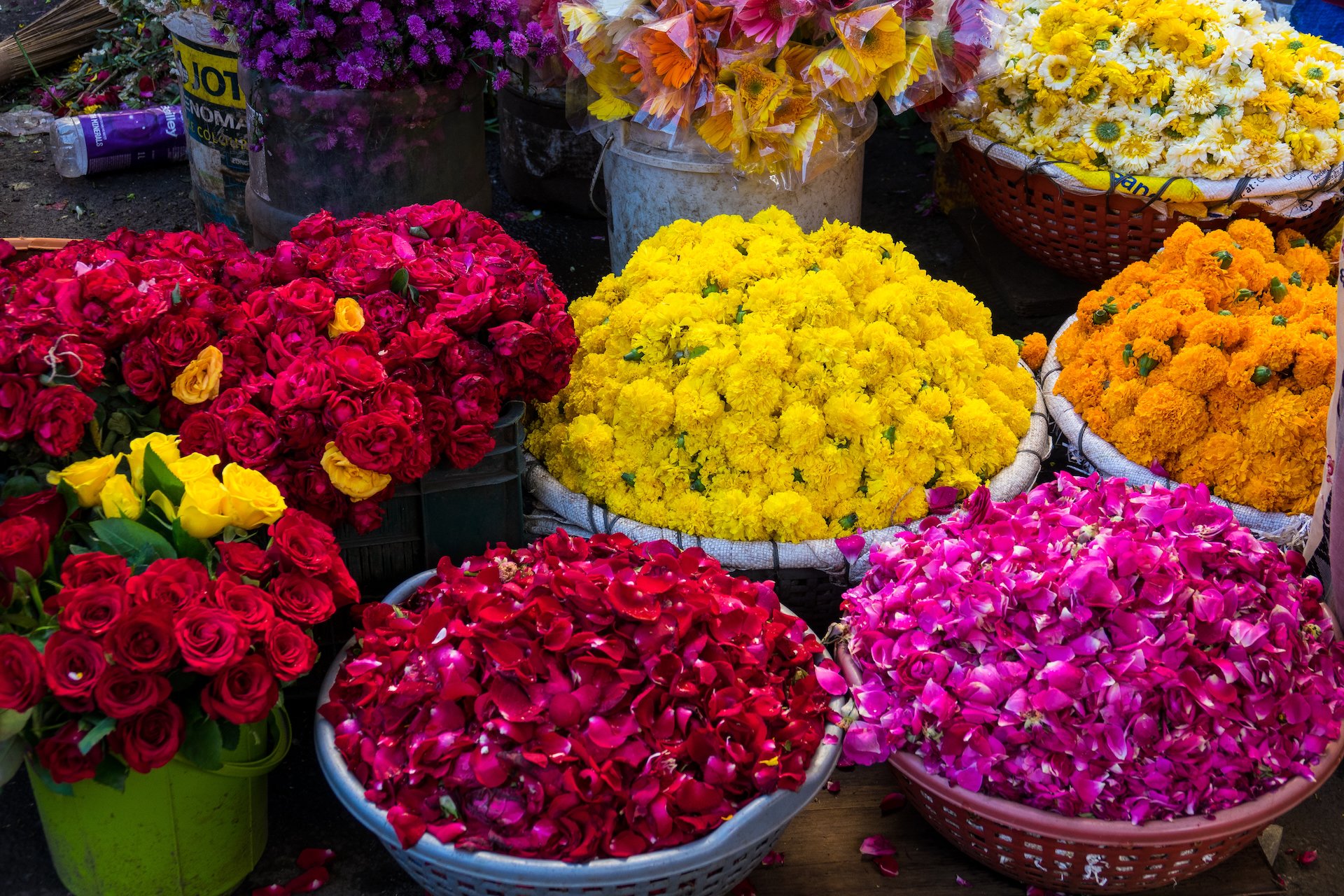
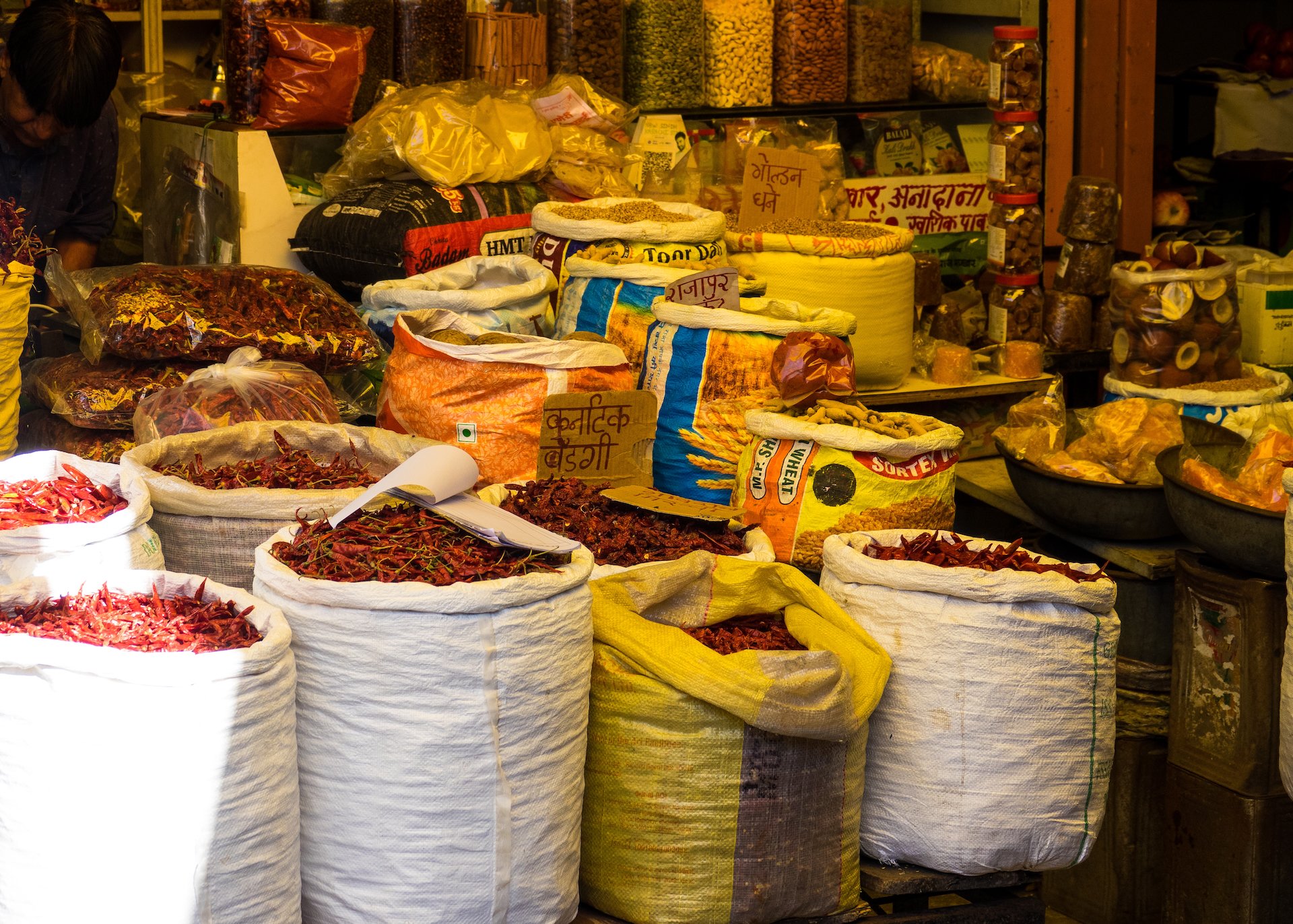
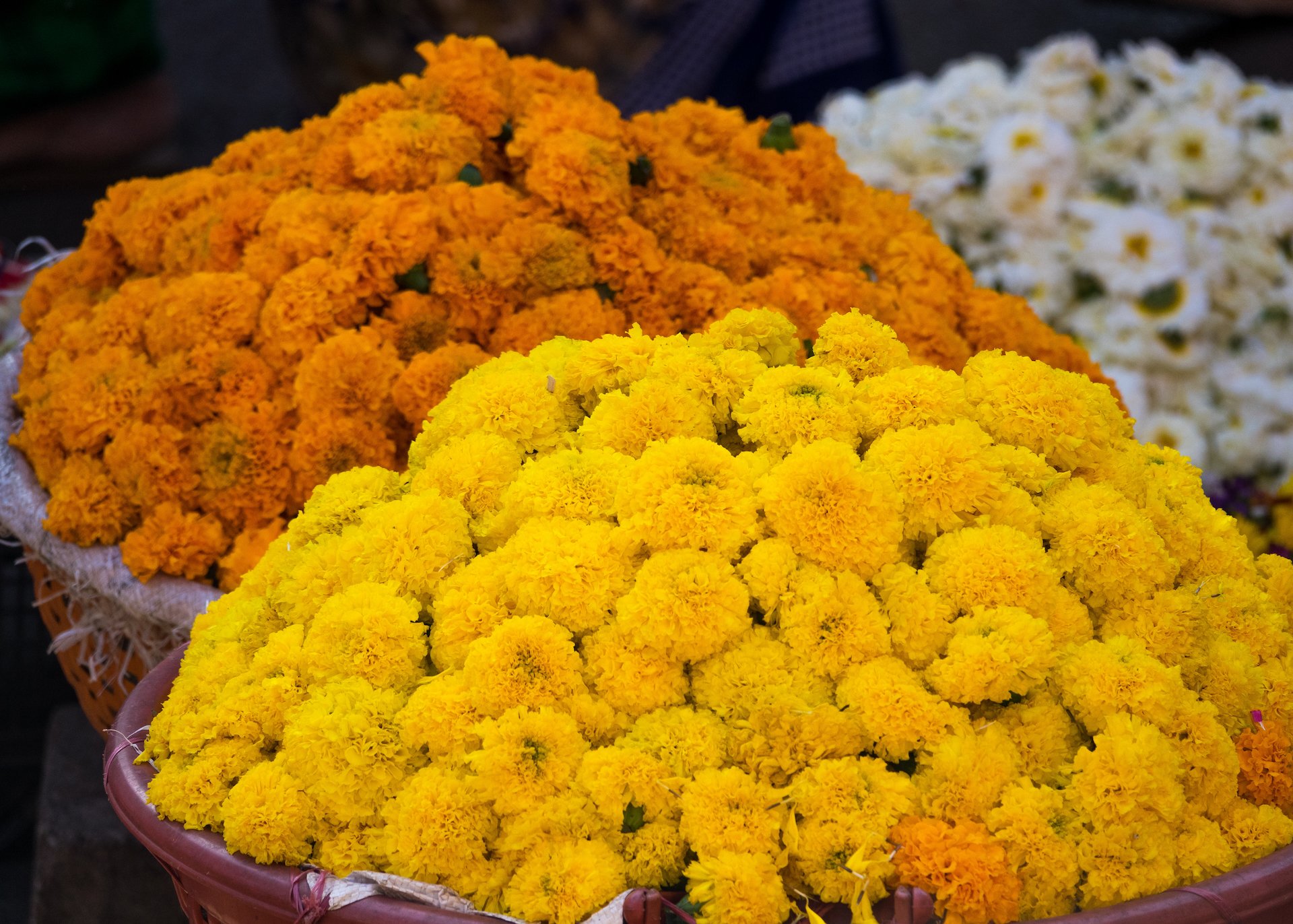
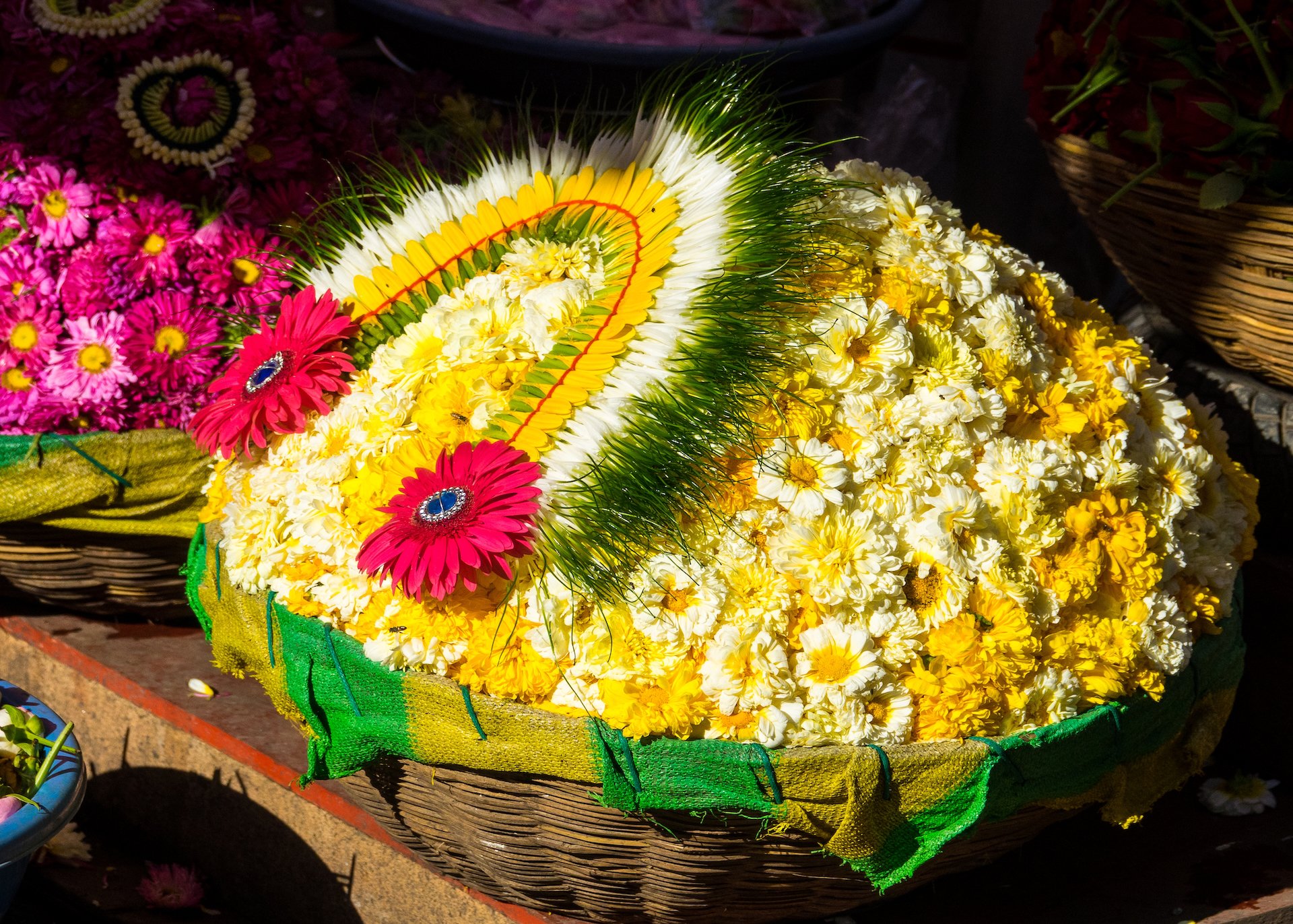

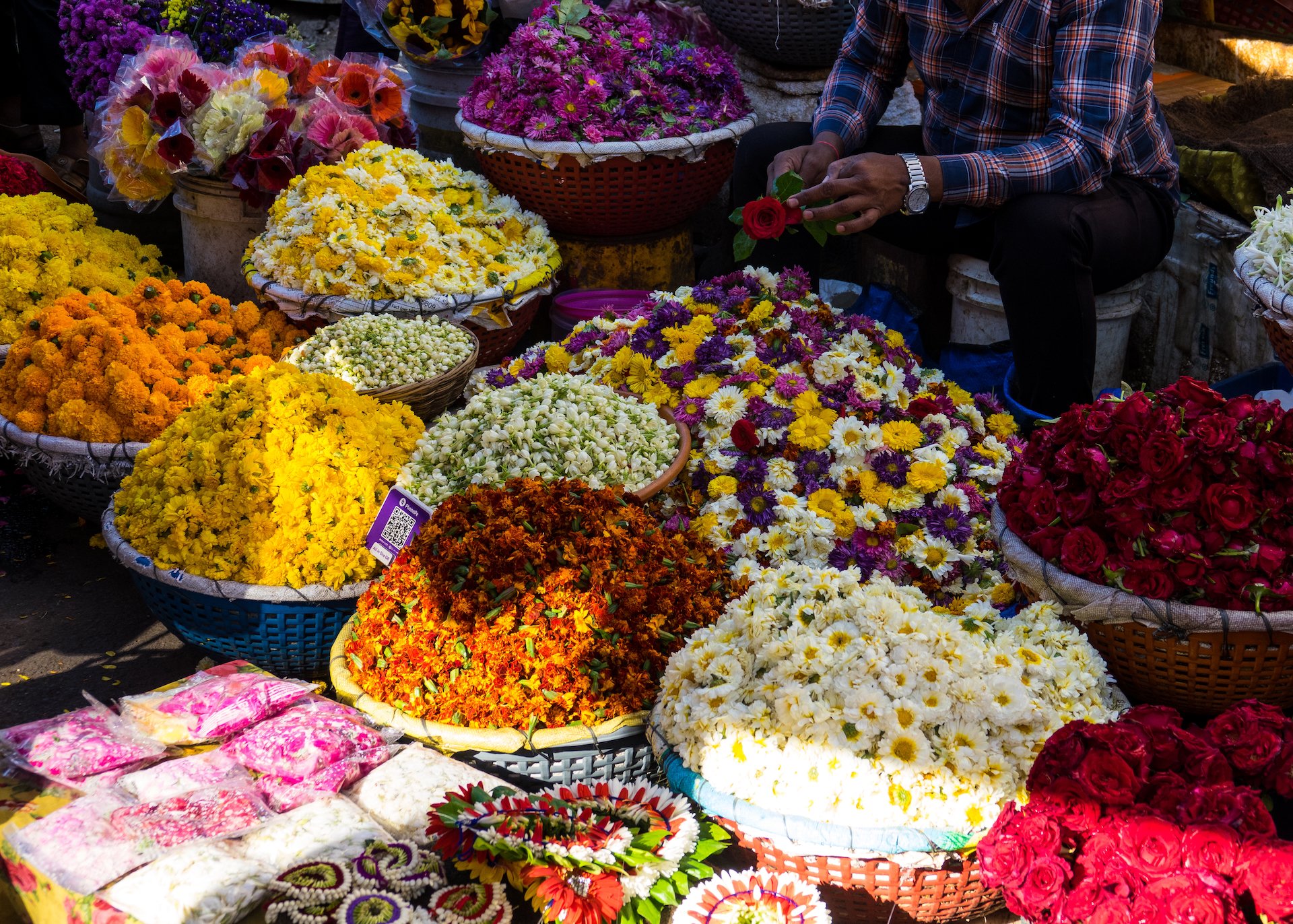
After that, things went off the rails. We tried to get the two groups back together, but that went horribly wrong. Our group had to split into two smaller groups to take the small, three-wheel tuk tuks across town to the meeting place. Our group got there, but the other ended up in a completely different part of town. It probably took an hour to get things sorted out and all of us back together again.
It was a full day, and a good one, but I was ready to get back to the hotel and chill out for the rest of the evening.
